Over the past 100 years, the world has witnessed the gradual emergence of a new entity: a collective centre for men’s souls
called the Mashriqu’l-Adhkár.1‘Abdu’l-Bahá, Selections from the Writings of ‘Abdu’l-Bahá, no. 60.1, in The Institution of the Mashriqu’l-Adhkár: A Compilation of Extracts from the Writings of Bahá’u’lláh and ‘Abdu’l-Bahá, the Writings of Shoghi Effendi, and the Letters of the Universal House of Justice, prepared by the Research Department of the Universal House of Justice (September 2017) #16. Available at https://www.bahai.org/library/authoritative-texts/compilations/institution-mashriqul-adhkar/. This dawning place of the mention of God
was created by Bahá’u’lláh,2 In the Kitáb-i-Aqdas, His book of laws, Bahá’u’lláh describes the Mashriqu’l-Adhkár as each and every building which hath been erected in cities and villages for the celebration of My praise, par. 115. In The Institution of the Mashriqu’l-Adhkár #2. and in the Bahá’í writings, the term refers, in different contexts, to gatherings, to structures, and to the institution of the Mashriqu’l-Adhkár3In a letter to an individual believer dated 20 April 1997, the Universal House of Justice wrote, The term ‘Mashriqu’l-Adhkár’has been used in the Writings to describe various things: the gathering of the friends for prayers at dawn; a building where this activity takes place; the complete institution of the Mashriqu’l-Adhkár, with its dependencies; the central edifice of that institution, often described as a House of Worship or Temple. These variants can all be seen as denoting stages or aspects of the gradual introduction of Bahá’u’lláh’s concept as promulgated in the Kitáb-i-Aqdas. In The Institution of the Mashriqu’l-Adhkár #73. See also the letter of the Universal House of Justice to the Bahá’ís of Iran (18 December 2014). —variations that correspond to an evolving understanding and practice of worship
in relation to community development.
The first use of the term, with reference to gatherings, reflects the truth that any group of people in any locality in the world can create the spiritual environment of the Mashriqu’l-Adhkár when they gather together to pray; the second, in conjunction with structures, indicates a dedicated space, an outward frame
that reveals the inward reality
;4‘Abdu’l-Bahá, from a Tablet translated from the Persian, in The Institution of the Mashriqu’l-Adhkár #21. and the third signals the emergence of a formal institution as the inward reality
strengthens and is expressed through action. In fact, ‘Abdu’l-Bahá described the Mashriqu’l-Adhkár as one of the most vital institutions in the world.
5‘Abdu’l-Bahá, Selections from the Writings of ‘Abdu’l-Bahá, no. 64.1. In The Institution of the Mashriqu’l-Adhkár #18. Elaborating on this, the Universal House of Justice refers to it as the focal point of the community from which it emerges
because it not only provides a space for worship but also encompasses dependencies; together, these embody two essential and inseparable aspects of Bahá’í life: worship and service.
6Universal House of Justice, from a letter to the Friends Gathered in Santiago, Chile, for the Dedication of the Mother Temple of South America (14 October 2016). In The Institution of the Mashriqu’l-Adhkár #69.
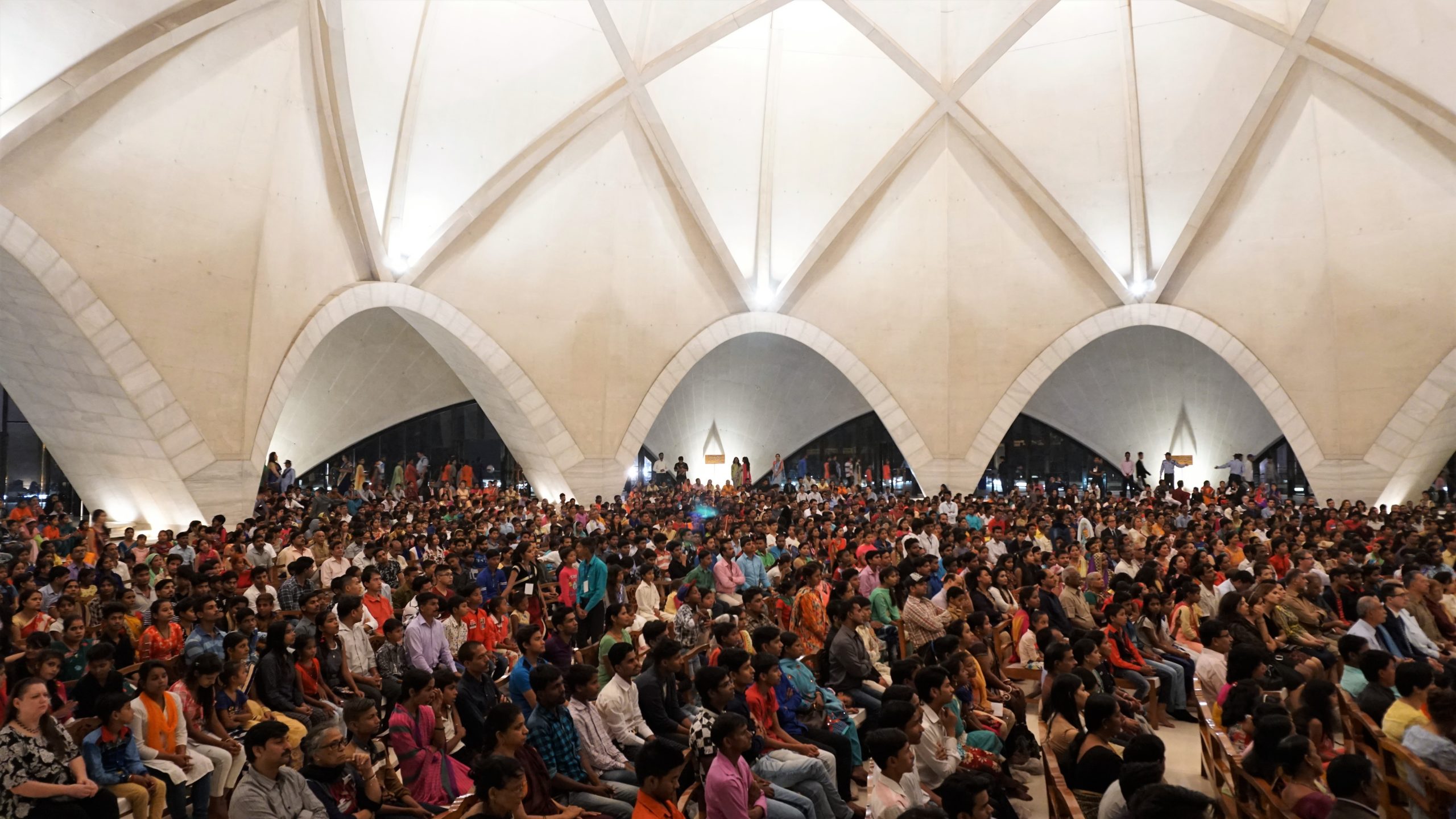
Worship, in Bahá’í practice, is simple in form and open to all. In devotional gatherings, which the Universal House of Justice has called “seeds of future Mashriqu’l-Adhkárs,”7 In a letter to the Bahá’ís of Iran (18 December 2014), the Universal House of Justice wrote: Beloved friends: Gatherings dedicated to prayer throughout your blessed land, in every neighbourhood, town, village, and hamlet, and the increasing access that your compatriots are gaining to Bahá’í prayers are enabling your community to shine the light of unity in the assemblage of humanity, lending a share to the endeavours of your fellow believers throughout the world. Plant, then, the seeds of future Mashriqu’l-Adhkárs for the benefit of all, and ignite countless beacons of light against the gloom of hatred and inequity. In The Institution of the Mashriqu’l-Adhkár #67.any soul may enter, inhale the heavenly fragrances, experience the sweetness of prayer, meditate upon the Creative Word, be transported on the wings of the spirit, and commune with the one Beloved.8Universal House of Justice, from a letter to the Conference of the Continental Boards of Counsellors (29 December 2015). In The Institution of the Mashriqu’l-Adhkár #68. In a Mashriqu’l-Adhkár, worship is likewise without ritual or set patterns, and the object is the same. As Shoghi Effendi wrote, “the more universal and informal the character of Bahá’í worship in the Temple the better.”9From a letter written on behalf of Shoghi Effendi to the National Spiritual Assembly of the United States and Canada (11 April 1931). In The Institution of the Mashriqu’l-Adhkár #45. Sacred scriptures from the Bahá’í Faith and other religions are read or chanted; there is no sermon or lecture, no collection of funds, no instrumental music, and no segregation for any reason such as sex, religion, or caste. Likewise, as service to humanity is an element of Bahá’í life in communities everywhere, no matter what their size or means, in communities where a Mashriqu’l-Adhkár emerges, the purpose of its dependencies is to systematize the facilitation of service to the common good by providing “centres of education and scientific learning as well as cultural and humanitarian endeavour” and by promoting the application of knowledge “to serve social and spiritual progress.”10Universal House of Justice, from a letter to the Bahá’ís of Iran (18 December 2014). In The Institution of the Mashriqu’l-Adhkár #67. Crucially, these two aspects of worship and service cannot be isolated from each other. Until “translated and transfused”into “dynamic and disinterested service to the cause of humanity,” the results of worship are limited;11Shoghi Effendi, from a letter to the beloved of the Lord and the handmaids of the Merciful throughout the United States and Canada (25 October 1929), in Bahá’í Administration: Selected Messages 1922–1932 (Wilmette: Bahá’í Publishing Trust, 1974, 1998 printing), 184–86; in The Institution of the Mashriqu’l-Adhkár #38. the dependencies of the Mashriqu’l-Adhkár both promote this change and provide channels for it.
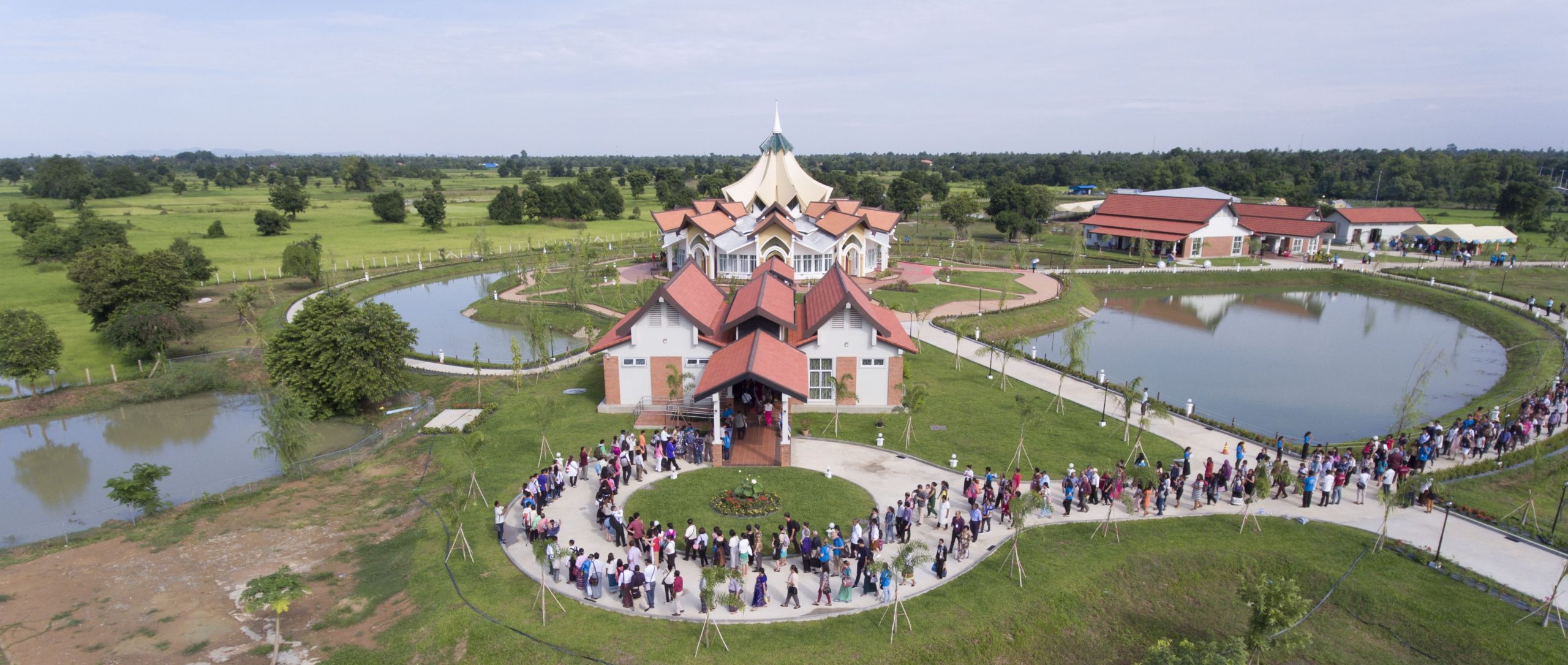
The physical and organizational structures associated with the Mashriqu’l-Adhkár emerge organically as understanding matures and a community develops the capacity for effective action. Because the physical structure provides a space for a growing number of people to gather to worship and to serve the broader community, it is important that the space created be welcoming to all. Therefore, the physical requirements, like the practice of worship inside the Mashriqu’l-Adhkár, are simple: It must have nine sides with nine entrances, signaling its openness to all. Inside, there are no pulpits or altars, and no pictures, icons, or statues. Most importantly, it should be beautiful and “as perfect as is possible in the world of being,”12Bahá’u’lláh, The Kitáb-i-Aqdas: The Most Holy Book, par. 31. In The Institution of the Mashriqu’l-Adhkár #1. so as to act as a means of “nurturing an attraction to the sacred.”13Universal House of Justice, on the occasion of the dedication of the House of Worship in Santiago, Chile (14 October 2016). Furthermore, the design should be integrated with the culture of its location—a feature amply demonstrated in the diversity of the Houses of Worship that have been constructed to date.14Designs have been diverse and innovative. In some cases, the architects have been told that what they have been envisioned is impossible—and yet they have achieved it. For example, in Chicago, the architect’s design resulted in engineering innovations in the use of concrete; in Germany, the modern design immediately distinguished this place of worship from traditional structures associated with other faiths. In India, the architect chose the motif of the lotus flower, a sacred symbol that resonates with the population irrespective of religious affiliation; Apia’s Temple is based on the open design of a traditional Samoan meeting house, and Panama’s open design incorporates indigenous motifs in the supporting brickwork. Many of the designs have won awards for their engineering and design innovations. In locations where local Houses of Worship are planned or have been recently constructed, the Bahá’í community has entered into a consultative process with the local population to generate a sense of ownership by all.15These consultative meetings have addressed topics such as the building design and the surrounding gardens. In Norte del Cauca, this brought about a plan to restore native species of plants and trees that had largely disappeared from the region.
BEGINNINGS: ‘ISHQÁBÁD AND CHICAGO
Ten Mashriqu’l-Adhkárs currently exist throughout the world. The first eight were built to serve as continental-level Temples in Chicago, the United States of America, for North America; Kampala, Uganda, for Africa; Sydney, Australia; Frankfurt, Germany, for Europe; Panama City, Panama, for Central America; Apia, Samoa, for Australasia; New Delhi, India; and Santiago, Chile, for South America. Local Houses of Worship have been completed in Battambang, Cambodia, and in Agua Azul, in the Norte del Cauca region of Colombia. Five more are in some stage of development: two national-level Temples in Papua New Guinea and the Democratic Republic of the Congo, and three more local Houses of Worship in Tanna, Vanuatu; Bihar Sharif, India; and Matunda Soy, Kenya. The determination as to where and when one will take physical shape in a community is made by the Head of the Faith and corresponds to that Bahá’í community’s capacity to embrace both the spiritual and practical aspects associated with it—to engage in sustained, long-term action to assist large numbers of people in a process of transformation that is both individual and collective, spiritual and material. The Bahá’í world community is still at the beginning of this temple-building process, but a look at how the world’s first two Bahá’í Houses of Worship took shape over a century ago offers some insights as to how this unique institution can develop in widely differing matrices and provides some historical context for the current efforts to construct national and local Mashriqu’l-Adhkárs.
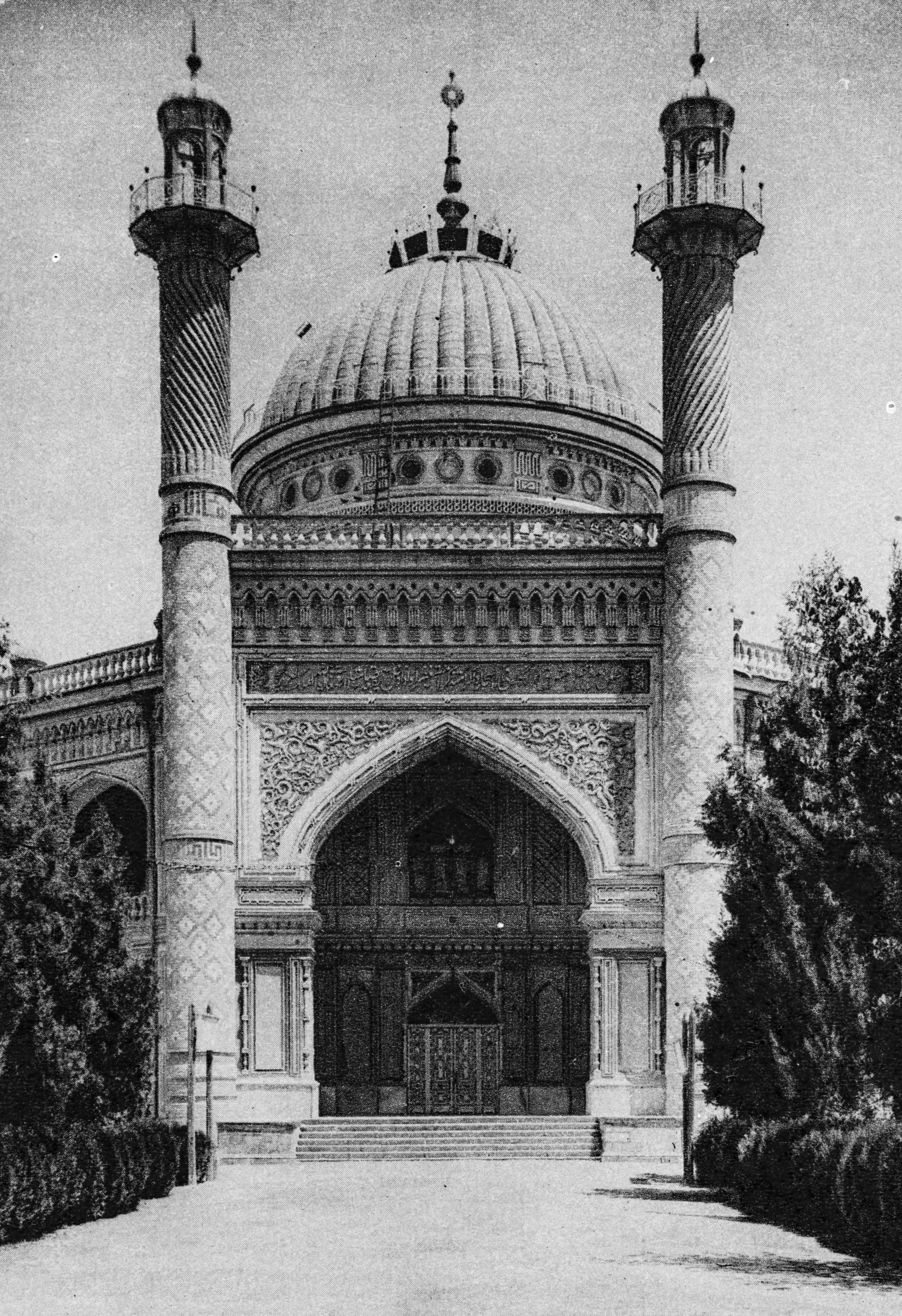
The world’s first Bahá’í House of Worship was built in ‘Ishqábád16Alternate transliterations are Ashgabat or Ashkhabad.in the Russian Transcaspian province close to the border of what is present-day Iran, where a small group of Persian Bahá’ís had settled to escape persecution in their home country. The first few adherents arrived around 1884; by 1890, there were some 400 and by 1902, approximately 1,000. As early as 1887 they acquired land and began to develop facilities for communal well-being,
including a meeting hall, schools for both boys and girls, a travelers’ hospice, and a clinic—all of which were established in an environment of unified endeavour and progress.
17Universal House of Justice, from a letter to the Bahá’ís of the World (1 August 2014). In The Institution of the Mashriqu’l-Adhkár #66. Significantly, Bahá’u’lláh Himself approved the land for the project. Later, acting on directions from ‘Abdu’l-Bahá, the community commenced construction on the Mashriqu’l-Adhkár in 1902.
One writer’s description conveys the organic nature of the process through which the House of Worship emerged: …they purchased a piece of ground, made it a beautiful garden, held open air meetings in the summer time; and when they could, erected a frame structure, which was used as a school for the Bahai children during week days; until finally—nine years after the ground was purchased, … they commenced the edifice ….
18Cited in R. Jackson Armstrong Ingram, Music, Devotions, and Mashriqu’l-Adhkár, Studies in Bábí and Bahá’í History (LA: Kalimat Press, 1987), 127. It is significant that the starting point of the community’s effort to develop its Mashriqu’l-Adhkár was by raising the level of the community’s social and economic development—notably, eliminating illiteracy by establishing educational facilities for all the children.
While the Bahá’í community of ‘Ishqábád achieved a high degree of internal unity, the wider social environment was not widely accepting of—and was, in some cases, openly hostile to—the teachings of the new faith. Thus, the spiritual encouragement and material support that the community received from elsewhere were doubly important. The Bahá’ís there must have been heartened by ‘Abdu’l-Bahá’s promise that such a material structure
would have a spiritual effect
and a powerful influence on every phase of life
19‘Abdu’l-Bahá, Selections from the Writings of ‘Abdu’l-Bahá 60.1. In The Institution of the Mashriqu’l-Adhkár #16. and by His assertion that He longed to participate in the construction Himself.20In one letter, He wrote: Were ‘Abdu’l-Bahá not imprisoned and were there not obstacles in his path, he himself would assuredly hasten to ‘‘Ishqábád and carry the earth for the building of the Mashriqu’l-Adhkár with the utmost joy and gladness. ‘Abdu’l-Bahá, cited in a letter from the Universal House of Justice to the Bahá’ís of the World (1 August 2014). As the work neared completion, ‘Abdu’l-Bahá wrote that the news had brought him infinite joy
and declared that it would become a place of great happiness,
without peer or likeness.
21‘Abdu’l-Bahá, from a Tablet translated from the Persian. In The Institution of the Mashriqu’l-Adhkár #24.
In this great building project, the Bahá’í community of ‘Ishqábád was fortunate to have the support of an individual who sacrificially contributed a significant portion of the funds,22His name was Hájí Mírzá Muhammad-Taqí Afnán. ‘Abdu’l-Bahá’s tribute to him can be found in Memorials of the Faithful (Wilmette: US Bahá’í Publishing Trust, 1971), 126–29. In it, He extolls him as the first builder of a House to unify man, 128. ut while his generosity was instrumental, the Bahá’í community as a whole was also directly involved, which allowed it to develop capacity to administer the affairs of the local Bahá’í community in an atmosphere of unified purpose. 23It is important to note that only members of the Bahá’í community have the privilege to contribute to the Bahá’í funds and thus support the construction of a House of Worship. As ‘Abdu’l-Bahá wrote: The friends in ‘Ishqábád made the raising up of the Mashriqu’l-Adhkár the means of creating perfect fellowship. With the utmost love and sincerity, they elected a committee, and that committee attended to establishing, organizing, arranging, and designing the Mashriqu’l-Adhkár,
which was constructed in great soundness and majesty.
24‘Abdu’l-Bahá, from a Tablet translated from the Persian. In The Institution of the Mashriqu’l-Adhkár #20.
Through this focus, fortified by ties of camaraderie and animated by unity of purpose and a spirit of faithfulness,
the community reached a high degree of cohesiveness and development,
and its members became distinguished for their prosperity, magnanimity, and intellectual and cultural attainments.
25The Universal House of Justice, letter to the Bahá’ís of the world, 1 August 2014. Available at https://www.bahai.org/library/authoritative-texts/the-universal-house-of-justice/messages/20140801_001/1#980781985. In The Institution of the Mashriqu’l-Adhkár #66. One writer estimates that ‘Ishqábád was the first place where there was a conscious attempt to build up a Bahá’í community along the pattern laid down in the Bahá’í writings,
noting, Nowhere else was there both the numbers of Bahá’ís and the freedom sufficient to do this. In Iran, the numbers existed but not the freedom. Elsewhere in the Middle East, the numbers were not sufficient.
26Moojan Momen, The Bahá’í Community of Ashkhabad: Its Social Basis and Importance in Bahá’í History, in Cultural Change and Continuity in Central Asia. Ed. Shirin Akiner. (London: Kegan Paul, 1991), 300. http://www.momen.org/relstud/’Ishqábád.htm. Central to this development was the community’s rich pattern of life deriving its impetus from the power of the Creative Word
27The Universal House of Justice, letter to the Bahá’ís of the world, 1 August 2014.—a pattern that was ultimately given communal space in the House of Worship.
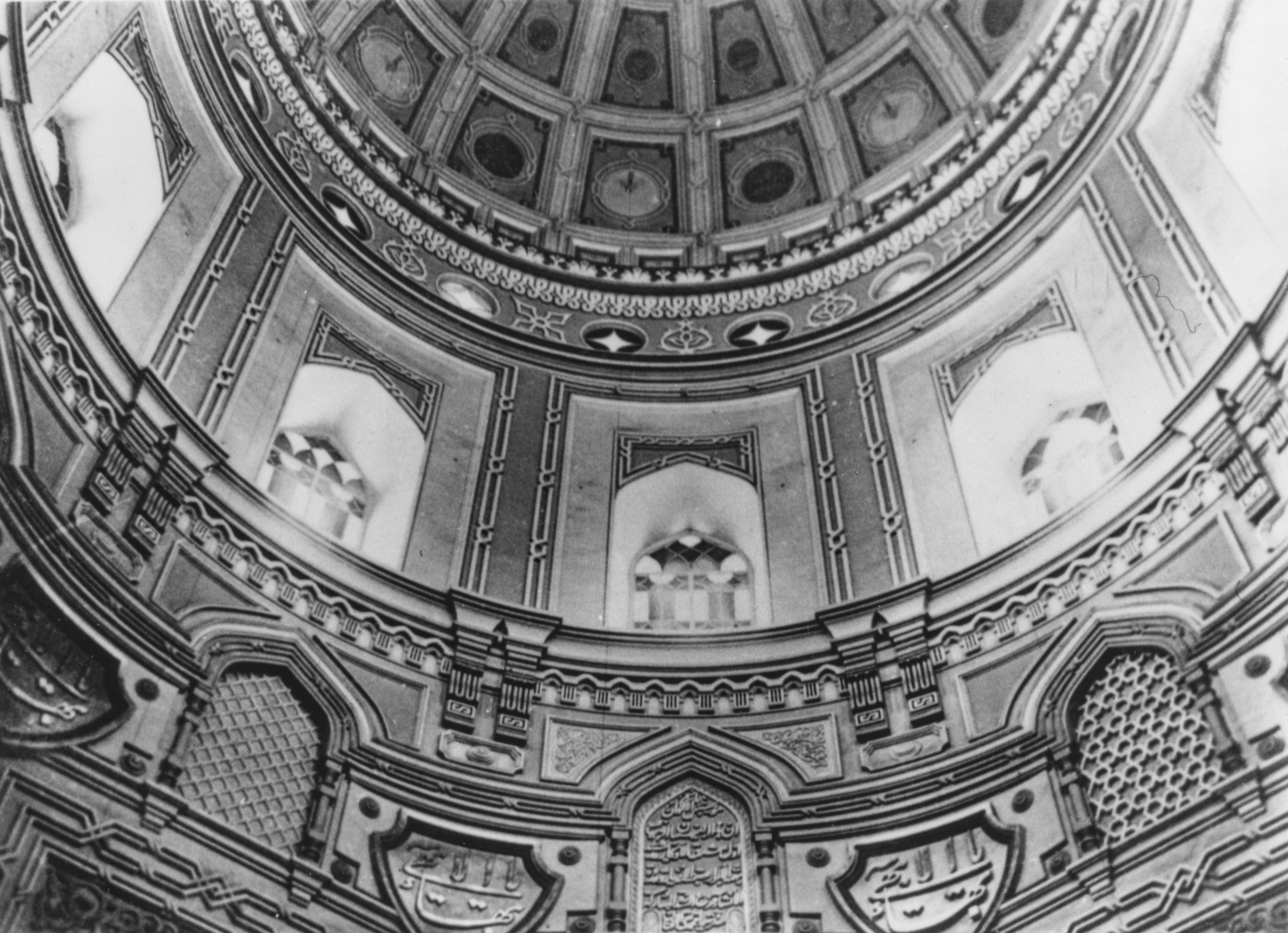
The initial challenge that the Bahá’í community of ‘Ishqábád faced was external opposition from Shi’ih Muslims. In 1890, for example, a prominent member of the Bahá’í community was murdered in the marketplace in full view of some 500 spectators who cheered the murderers on.28For accounts of this episode and its consequences, see Shoghi Effendi, God Passes By. First edition published 1944. Revised edition 1974 (Wilmette: Bahá’í Publishing Trust, 1974), 202–03; Nancy Ackerman and Graham Hassall, Russia and the Bahá’í Faith: A Historic Connection, The Bahá’í World 1998–99 (Haifa: Bahá’í World Centre, 2000), 162; Momen, 282–83. Fortifying itself to withstand such opposition and flourishing under the guidance of ‘Abdu’l-Bahá, the community became very unified, but its growth was limited—generated largely by the arrival of additional members from Iran. Following the Russian Revolution, the community faced further difficulties owing to the government’s anti-religious policies, and ultimately its life span was cut short. By 1938 the authorities had prohibited its activities, seized its properties, converted them to other uses, and exiled many of the members. The House of Worship itself was expropriated, used as a museum until it was damaged in an earthquake, and eventually demolished.29For more details, see Houses of Worship around the World: Ashgabat (Ashkhabad, ‘‘Ishqábád) in The Bahá’í Encyclopedia Project, www.bahai-encyclopedia-project.org. Nevertheless, its brief existence and the Bahá’í community’s efforts to construct a pattern of life that translated worship into active service to humanity stand as a powerful example to later generations.
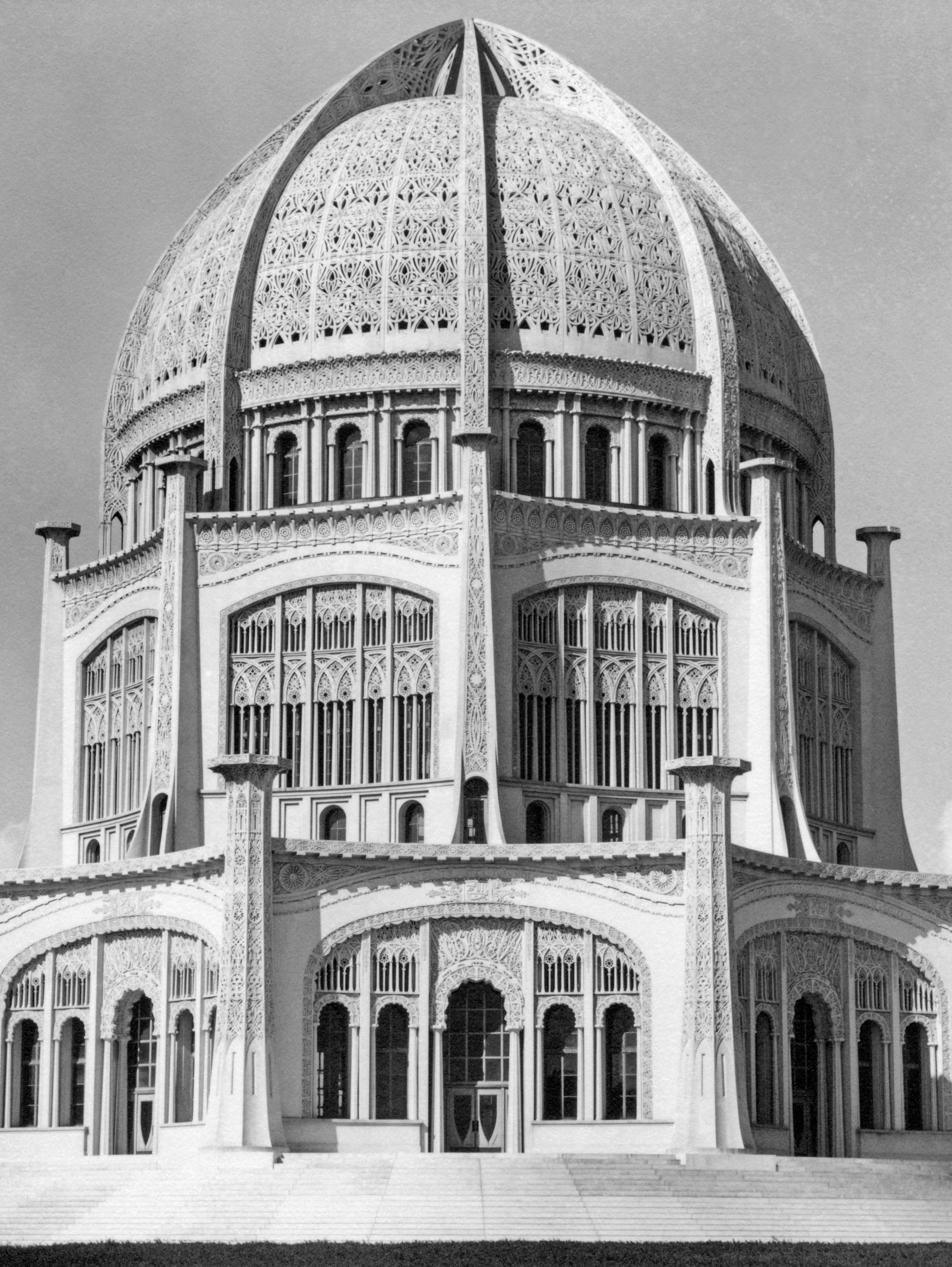
The process through which the construction of the world’s second Bahá’í House of Worship was undertaken was quite different. In 1903, learning about the initiative in ‘Ishqábád, a group of Bahá’ís in the Chicago area petitioned ‘Abdu’l-Bahá for permission to build a Mashriqu’l-Adhkár and received warm encouragement to undertake the project. However, the American matrix generated very different dynamics. As one author puts it, Although there had grown a substantial Bahá’í community in Chicago and although these Bahá’ís did in 1903 decide to build a House of Worship in emulation of the Ashkhabad House of Worship, there was not the same unity and community spirit nor the resources to equal the Ashkhabad achievements.
30Momen, 300.
While there was no external opposition to contend with, a number of geographic and cultural factors served as impediments. First, in contrast to the community in ‘Ishqábád, the North American Bahá’í community was composed of recent converts whose access to Bahá’í scripture was limited and whose new faith was tested by the falling away of the first teacher in North America. Second, the Bahá’ís lived in comparatively small and widely scattered centers throughout the continent—some 150 cities by 1906, but the communities were mostly modest in size and were spread throughout eleven states as well as the city of Montreal, in Canada.31Bruce Whitmore, The Dawning Place: The Building of a Temple, the Forging of a Global Religious Community, 2nd ed, revised and expanded (Wilmette: Bahá’í Publishing, 2015), 25. A third challenge to their unity arose from their culture’s prizing of individualism above collective endeavor, and a fourth came from gender inequality.
While the idea of building a Temple generated enthusiasm among many when it was first raised by the Bahá’í community in Chicago, there was also some confusion. What would be its scope? Some saw it as a local Mashriqu’l-Adhkár similar to the one they had read about in ‘Ishqábád, and a number of other communities immediately proposed building one of their own. However, ‘Abdu’l-Bahá swiftly guided them to think of the Chicago House of Worship not only as a national but as a continental effort that should be supported by Bahá’í communities throughout North America and around the world, especially those in Iran.
Establishing a climate of unity was hard work. Some objected to providing funds for a House of Worship in a distant location. Others resisted the call to support the Temple project because a woman, Corinne True, was initially one of the strongest forces behind it after being assigned the task by ‘Abdu’l-Bahá. Difficulties arose in reaching agreement about the site and the Temple design. Eventually, however, a parcel of land in Wilmette, north of Chicago, was agreed upon, and the cornerstone was laid by ‘Abdu’l-Bahá in 1912 during His visit to North America—a moment of great joy and triumph for the community. Nevertheless, decades of fundraising followed, and other challenges had to be surmounted before the project’s completion.
Its efforts to overcome these difficulties shaped the North American Bahá’í community. The construction of the Temple was, in the words of the Universal House of Justice, a complex project
that took decades to complete, through two world wars and a widespread economic depression
with each stage in its development … intimately tied to the expansion of the community and the unfoldment of its administration.
32The Universal House of Justice, letter to the Bahá’ís of the world, 1 August 2014. Throughout this process, the loving and infallible guidance of ‘Abdu’l-Bahá and Shoghi Effendi served as a catalyst for the community’s development by repeatedly raising its vision above the merely material. Shoghi Effendi stressed that It is devotion, sincerity and genuine enthusiasm which in the long run can ensure the completion of our beloved Temple. Material considerations, though essential, are not the most vital by any means.
33From a letter written on behalf of Shoghi Effendi to an individual believer (30 December 1933). In The Institution of the Mashriqu’l-Adhkár #48.
Ultimately, the tests of unity were overcome; institutions were established, matured, and learned how to function more and more effectively as they built both the Temple and a vibrant national community. As one writer has noted, The real strength of the early American believers, men and women, was not that they were like-minded individuals who formed a harmonious, homogeneous community, but that despite their strong individualism they allowed the teachings of Bahá’u’lláh and the guidance of ‘Abdu’l-Bahá to serve as beacons, as sources of inspiration and understanding, as they struggled to build a community that drew its unity from its diversity.
34Whitmore, 28. This is a key achievement of the North American Bahá’ís through their temple-building project.
Time and again, the Guardian, Shoghi Effendi, told the Bahá’ís of North America that no other House of Worship would ever possess the vast, the immeasurable potentialities with which this Mother Temple of the West, established in the very heart of so enviable a continent, and whose foundation stone has been laid by the hand of the Center of the Covenant Himself, has been endowed.
35Shoghi Effendi, letter to the Bahá’ís of North America (28 March 1943), This Decisive Hour #108, https://www.bahai.org/library/authoritative-texts/shoghi-effendi/decisive-hour/5#638973491. Two of these immeasurable potentialities, the expansion of the community
and the unfoldment of its administration,
bear a closer look. Unlike ‘Ishqábád, there were no external conditions to limit the growth of the Bahá’í community in the United States, and both ‘Abdu’l-Bahá and Shoghi Effendi linked the temple-building process to the expansion of the Faith. Accordingly, both potentialities were developed conjointly. By 1944, for example, acting on the guidance of the Guardian, the North American community had completed the exterior of the House of Worship and established Bahá’í communities in every state of the United States and every province of Canada. Furthermore, the number of nine-member local Bahá’í councils, called Local Spiritual Assemblies, had doubled on the continent in a period of seven years, and Bahá’í communities were taking root in Central and South America—many supported by Bahá’í pioneers
who moved there from North America.36See Whitmore, 183.
In a letter dated 28 March 1943, the Guardian described the role the House of Worship in North America was destined to play in hastening the emergence of the World Order of Bahá’u’lláh.
37Shoghi Effendi, So Meritorious an Undertaking (28 March 1943) in This Decisive Hour: Messages from Shoghi Effendi to the North American Bahá’ís 1932-1946, #108. Available at https://www.bahai.org/library/authoritative-texts/shoghi-effendi/decisive-hour/5#860561591. Advancement towards this goal is evident from the early years, in the gradual transfer of responsibility for the Temple project from an individual to a collective level. While ‘Abdu’l-Bahá had tasked Corinne True to spearhead the project when she had gone on pilgrimage in 1907, by 1920 He widened the scope of responsibility, counselling that all the affairs
related to the Mashriqu’l-Adhkár are to be referred to the annual Convention
and that Whatever the Convention, with a majority of opinions, decides, must be accepted and executed.
38Cited in Nathan Rutstein, with the assistance of Edna M. True, Corinne True: Faithful Handmaid of ‘Abdu’l-Bahá (Oxford: George Ronald, 1987), 149. Another step towards realizing this vision of the North American Bahá’í community’s role in hastening the emergence of the World Order of Bahá’u’lláh
was the establishment and development of the institution of the Hazíratu’l-Quds (literally, sacred fold
) in concert with the House of Worship. Its purpose was to accommodate the community’s administrative work, serving as the seat of the Bahá’í National Assembly and pivot of all Bahá’í administrative activity in future.
39The Guardian described the function of the Hazíratu’l-Quds as follows: Complementary in its functions to those of the Mashriqu’l-Adhkár—an edifice exclusively reserved for Bahá’í worship—this institution, whether local or national, will, as its component parts, such as the Secretariat, the Treasury, the Archives, the Library, the Publishing Office, the Assembly Hall, the Council Chamber, the Pilgrims’ Hostel, are brought together and made jointly to operate in one spot, be increasingly regarded as the focus of all Bahá’í administrative activity, and symbolize, in a befitting manner, the ideal of service animating the Bahá’í community in its relation alike to the Faith and to mankind in general. Shoghi Effendi, God Passes By, rev ed (Wilmette: US Bahá’í Publishing Trust, 1974), 339–40. Available at https://www.bahai.org/library/authoritative-texts/shoghi-effendi/god-passes-by/24#198460320. acilities for communal well-being
such as those in ‘Ishqábád were not inaugurated until the construction was completed, when Shoghi Effendi called for the erection of the first dependency of the first Mashriqu’l-Adhkár of the western world.
40Shoghi Effendi, Citadel of Faith (Wilmette: US Bahá’í Publishing Trust, 1965), 108. Available at https://www.bahai.org/library/authoritative-texts/shoghi-effendi/citadel-faith/4#662916934. In response to this call, the Bahá’í Home for the Aged was established in 1959; it operated until 2002.
Looking at these first two Bahá’í Houses of Worship in ‘Ishqábád and Chicago allows us to see how differences in context and focus can affect the emergence of this institution and allow for emphasis to be given to one or another aspect, as appropriate to its matrix. In ‘Ishqábád, the Temple arose within the context of a very strong, active and united local community, and dependencies followed an organic course of development since public services, such as those related to the education of both boys and girls, for example, were not available. In Chicago, on the other hand, the Temple served as the catalyst for building unity of vision and purpose in the Bahá’í community of the entire continent of North America, developing its capacities to raise funds, to use the consultative process to achieve unity of thought and action regarding the design, to grow the community of believers attracted to the teachings of Bahá’u’lláh, and to develop administrative structures to guide and channel the energies of the community. Since public education and other services were widely available, Chicago did not devote energy to developing such dependencies; rather, under the guidance of Shoghi Effendi, it focused on building crucial administrative capacities that eventually affected the development and functioning of national and local Bahá’í communities throughout the entire hemisphere. In a sense, one could view the ‘Ishqábád Temple as a model for the emergence of a local House of Worship and the one in Chicago as a model for the continental
Houses of Worship that were established during the stage of temple building upon which the Bahá’í world community next embarked.
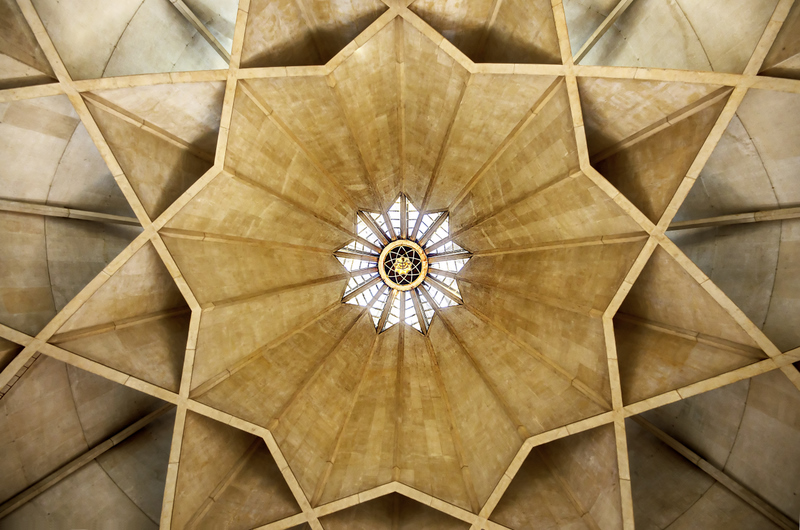
CONTINENTAL, NATIONAL, AND LOCAL HOUSES OF WORSHIP
With the dedication of the House of Worship in Wilmette in 1953, the Guardian called for the construction of mother temples
on other continents and, as Bahá’í National Assemblies were established in countries around the world, for the acquisition of lands to be used for future national temples. Like the North American House of Worship, these Mashriqu’l-Adhkárs represented beacons—visible manifestations of what will, over time, emerge in countless communities throughout the world. In contrast to the House of Worship in ‘Ishqábád, these continental temples did not emerge from matrices of intense local activity; rather, they represented a vision of worship and service to which emerging national Bahá’í communities in all parts of the world could orient themselves. They emerged over decades, their development guided by Shoghi Effendi and the Universal House of Justice: Africa (Kampala, Uganda) and Australia (Sydney) in 1961, Europe (Langenhain, Germany) in 1964, Central America (Panama City) in 1972, Oceania (Apia, Samoa) in 1984, and the Indian Subcontinent (Bahapur, New Delhi) in 1986. Only the South American Temple remained for many years unbuilt, and it was not until October 2016 that some 3,000 people from around the world gathered in Santiago, Chile, for its dedication—a moment that marked the culmination of a process set in motion over a century before.
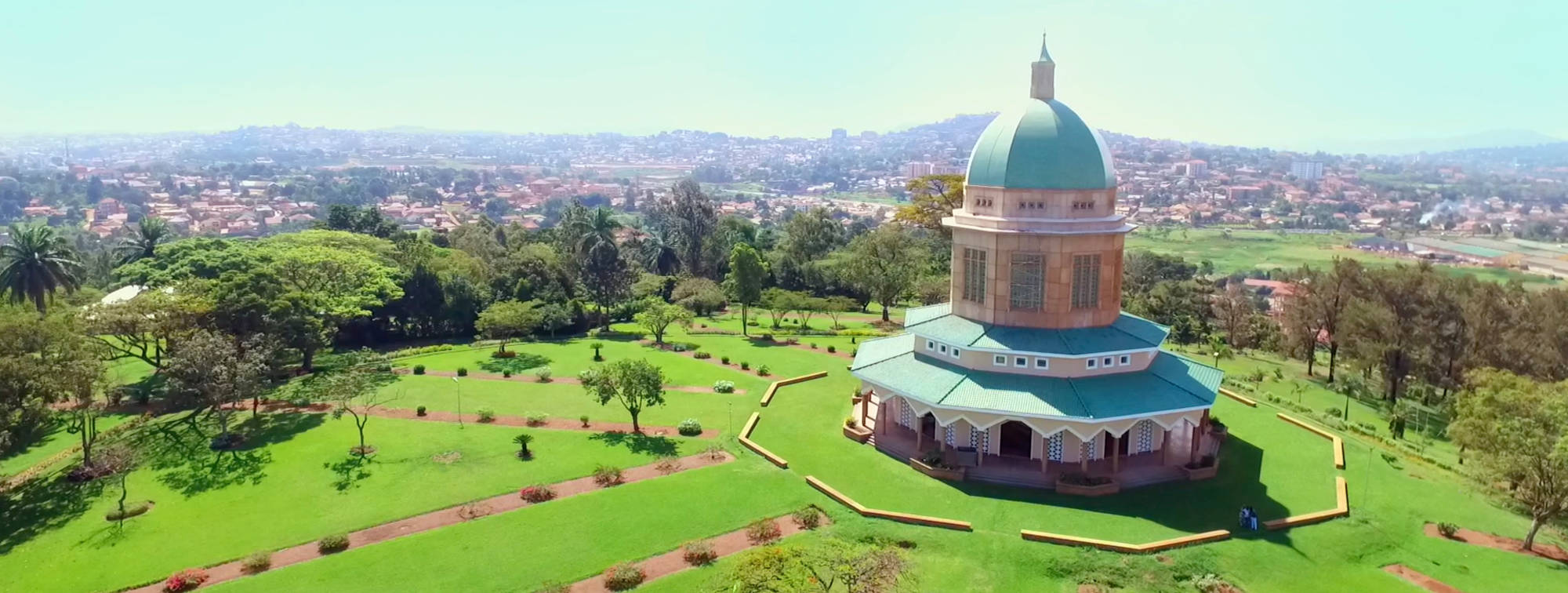
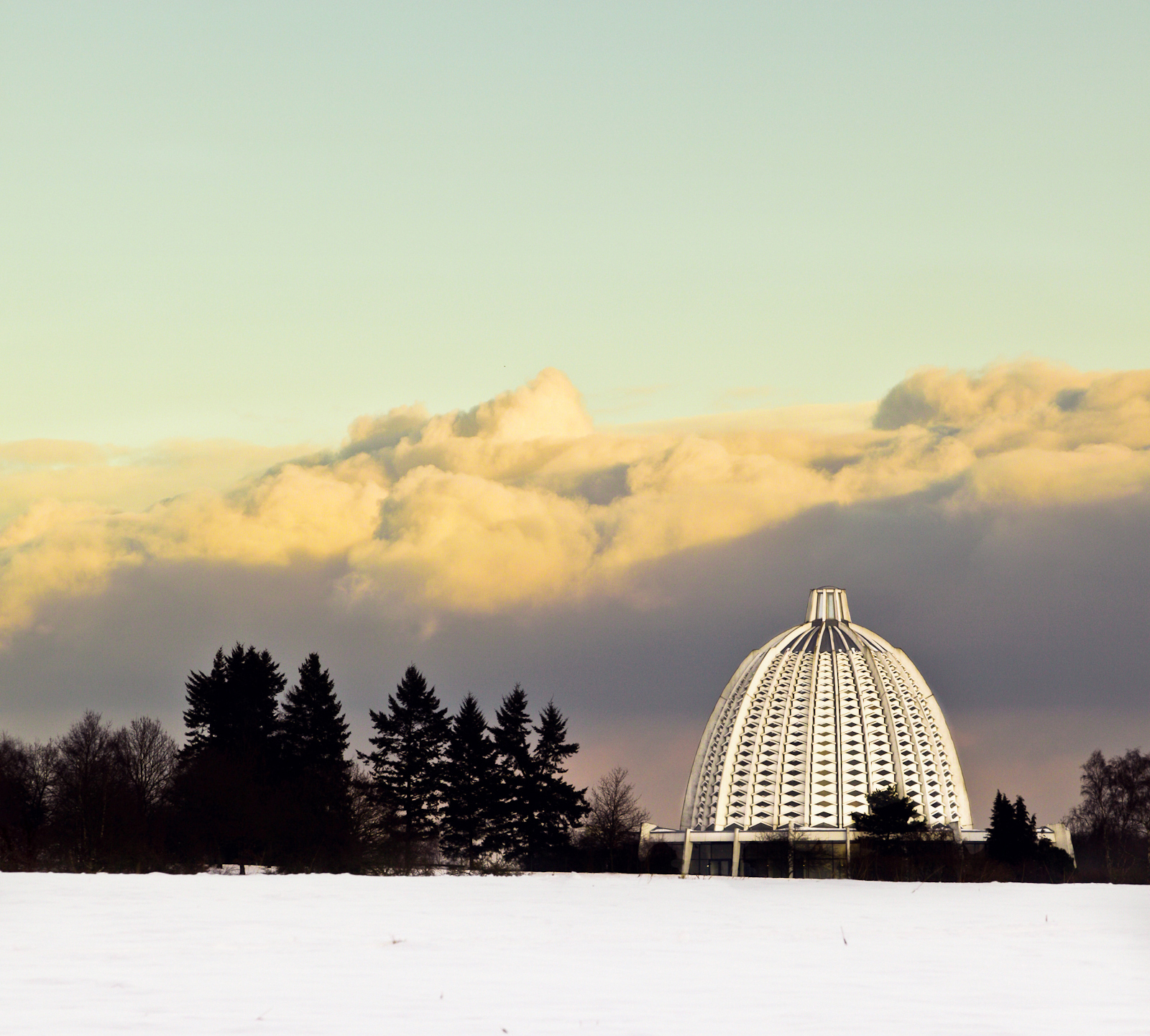
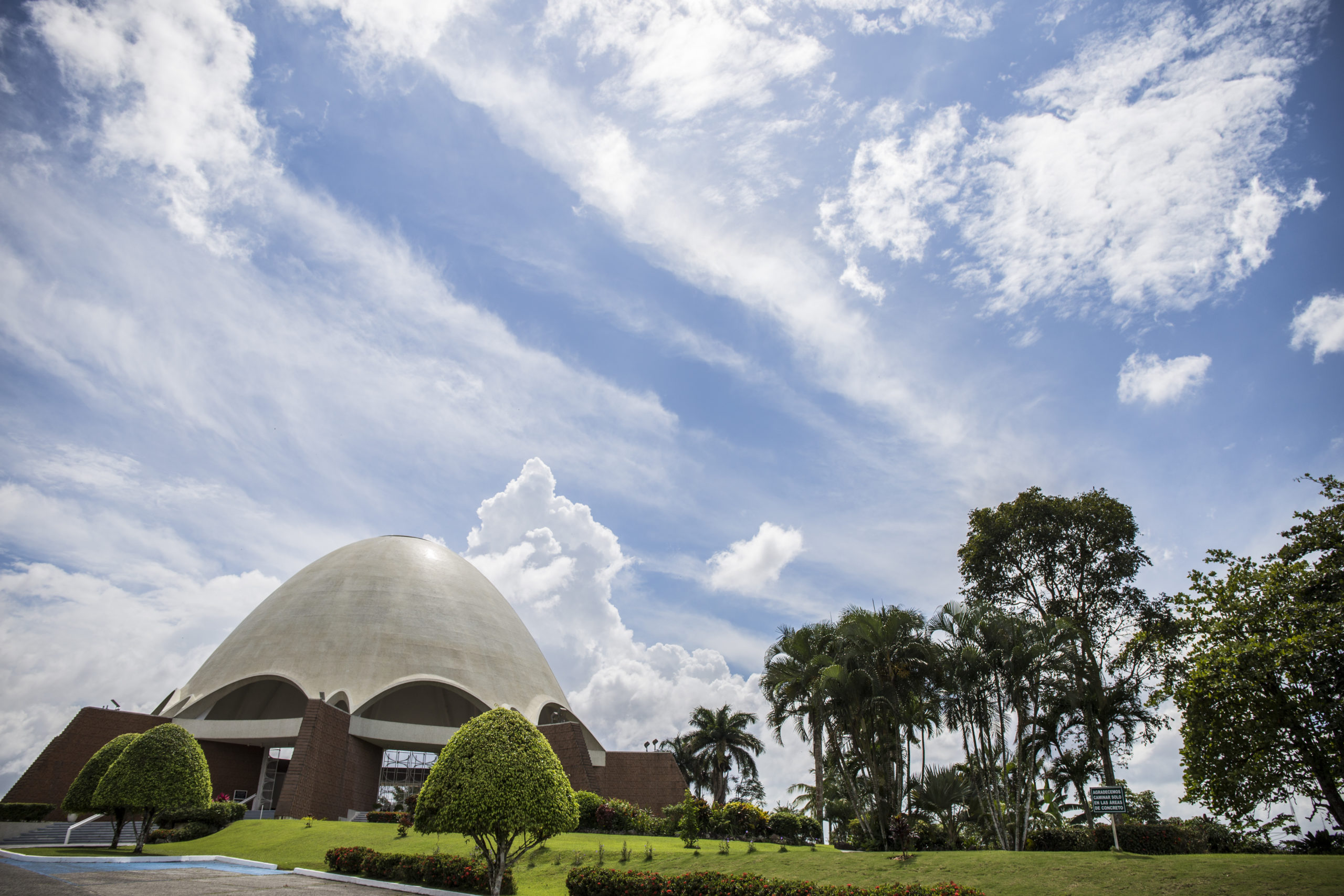
Only the South American Temple remained for many years unbuilt, and it was not until October 2016 that some 3,000 people from around the world gathered in Santiago, Chile, for its dedication—a moment that marked the culmination of a process set in motion over a century before.
By this time, the Bahá’í world community had embarked on a further stage in the development of the institution of the Mashriqu’l-Adhkár. In 2001, in its annual message to the Bahá’í world on the occasion of the Festival of Riḍván, the Universal House of Justice not only announced the construction of this final continental House of Worship, it also heralded the launch of a long-term process of raising up … national Houses of Worship, as circumstances in national communities permit
; 11 years later, at Riḍván 2012, it identified the Democratic Republic of the Congo and Papua New Guinea as the first two sites. This was an historic development, but there was more: in that same message, the House of Justice also announced that the first local Houses of Worship would be constructed in Battambang, Cambodia; Bihar Sharif, India; Matunda Soy, Kenya; Norte del Cauca, Colombia; and Tanna, Vanuatu. Progress on two of these local temples was very swift, and in September 2017—less than a year after the dedication of the final continental House of Worship—the world’s first local Bahá’í Mashriqu’l-Adhkár was dedicated in Battambang; this was followed, in July 2018, by the second, in Norte de Cauca, and plans are currently underway for the construction of the remaining three local and the two national temples.
To explore the reasons why the construction of these national and local Mashriqu’l-Adhkárs is timely and to understand their significance, it is helpful to examine the way they are described by the world-governing body. This will also aid us to reflect how the current process differs from efforts to build places of worship in previous religious dispensations.
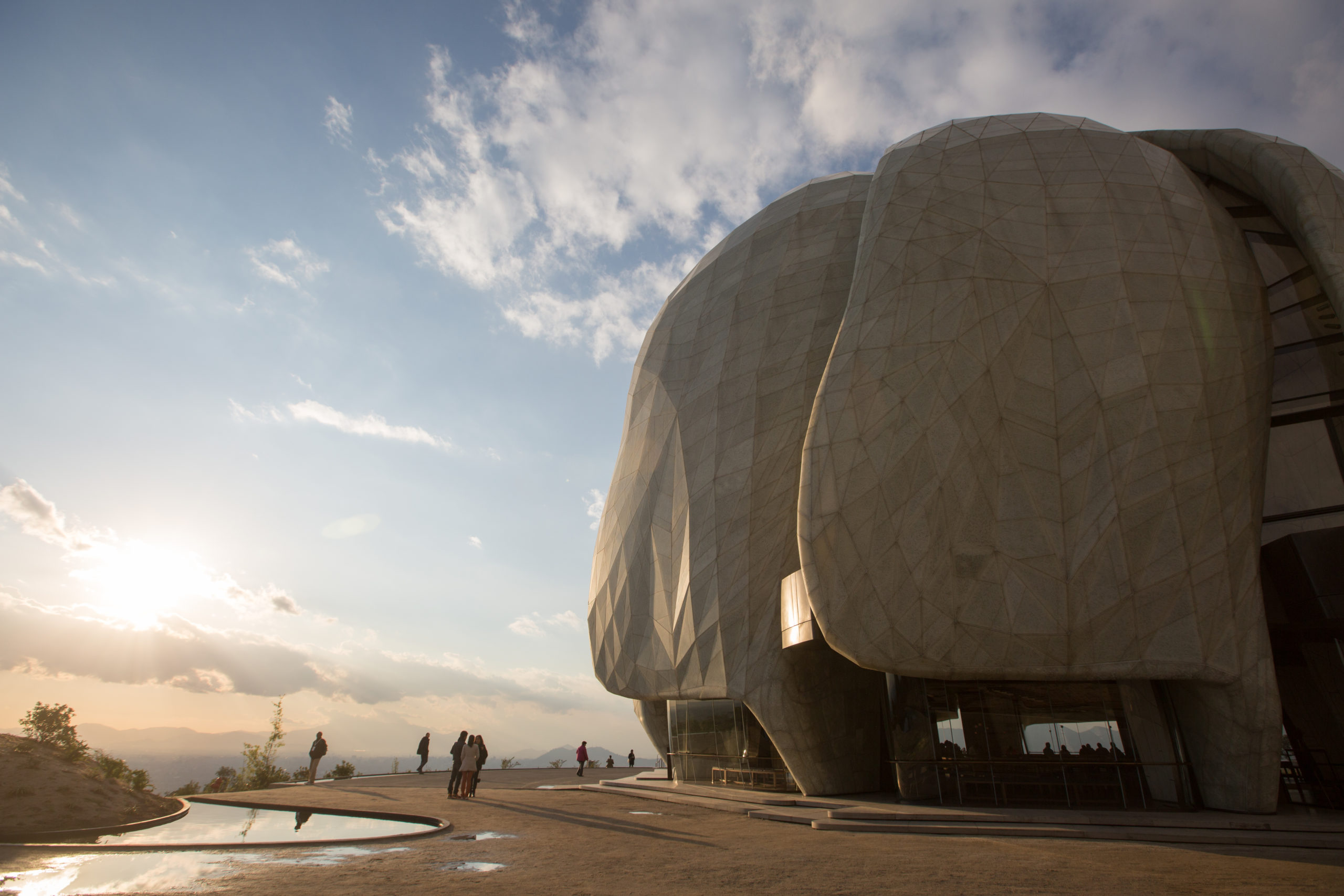
In its message to those gathered for the dedication of the Santiago House of Worship, the Universal House of Justice described how the Bahá’í community in the city, supported by Bahá’ís from other communities throughout North, Central, and South America, learned how to prepare the surrounding population for the emergence of the House of Worship
; this involved developing the capacity to engage increasing numbers of the city’s population to participate systematically in community-building endeavours
and to sustain their actions over time. Through these efforts, visitors began to go to the Temple both to pray and to consult about the practical and spiritual dimensions of the enterprise.
41Universal House of Justice, 1 August 2014. Through such means, construction and grassroots expansion efforts were for the first time united, marking a pivotal point in the global temple-building process.
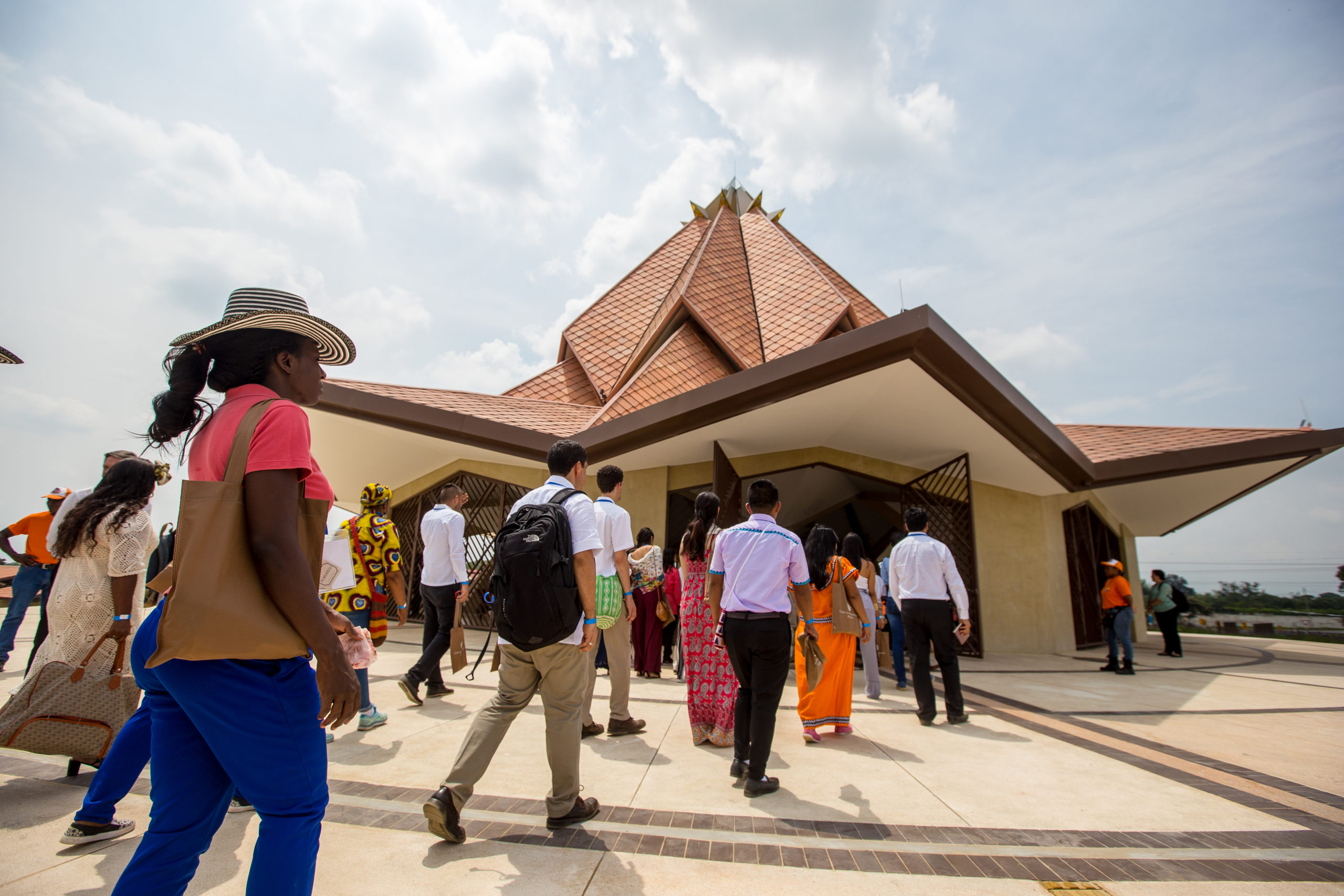
This emphasis on the preparation of the population for the emergence
of the Temple is related to the processes of growth that have been pursued persistently and unitedly by the Bahá’í world community since 1996 as the latest stage in its global program of expansion and consolidation—processes that can be viewed as the latest stage in a systematic process to spread the teachings of Bahá’u’lláh to all the peoples of the world. From the inception of the Faith, its teachings were carried afar by lone travelling teachers; during the time of ‘Abdu’l-Bahá, efforts became more focused, as individuals arose to travel or pioneer
in the far-flung countries or territories mentioned by Him in His Charter for the expansion of the Bahá’í community throughout the world, the Tablets of the Divine Plan. Under the direction of Shoghi Effendi, the diffusion was further broadened, as Bahá’ís settled and worked to establish communities in many more locations. Over time, these communities have taken root and flourished to the point where, during the past two decades, their members have learned how to effectively engage with friends, neighbors, coworkers, acquaintances, and receptive populations to work with them for the common weal.
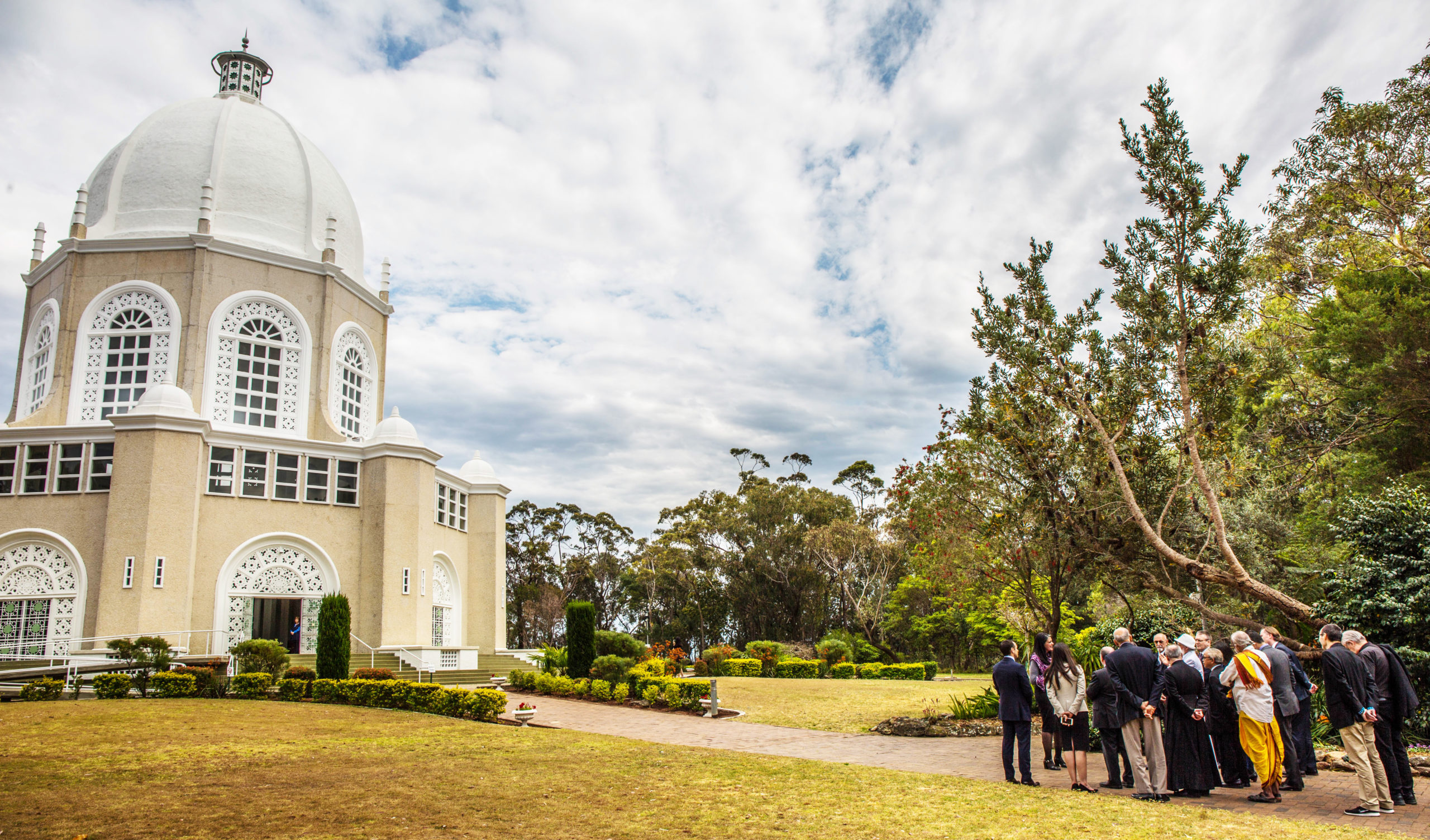
In its Riḍván 2012 letter, the Universal House of Justice wrote: … Humanity is weary for want of a pattern of life to which to aspire; we look to you to foster communities whose ways will give hope to the world.
To this end, Bahá’ís have focused on four core
community-building areas: the enhancement of the devotional character of the community, particularly through the holding of gatherings where all are welcome to join in prayer, meditation, and the sharing of inspirational and sacred readings from their own faiths and traditions; the spiritual education of children; a program for the moral and spiritual empowerment of young adolescents; and the study of materials that will develop participants’ capacities to become protagonists themselves in these community-building processes.
Efforts to establish this pattern of life, which the Universal House of Justice describes as a spiritual endeavour, one in which the whole community participates,
42Universal House of Justice, Riḍván 2013. unite both worship and service. Here, one can see the connection to the Mashriqu’l-Adhkár, which, Wherever it is established, … will naturally be an integral component of the process of community building that surrounds it
—an awareness that is growing in localities where Houses of Worship are emerging.43Universal House of Justice, Riḍván 2013. While these core activities are all intertwined, the one that is first encouraged and forms the basis of the eventual emergence of a local House of Worship is the holding of devotional gatherings—its seeds.
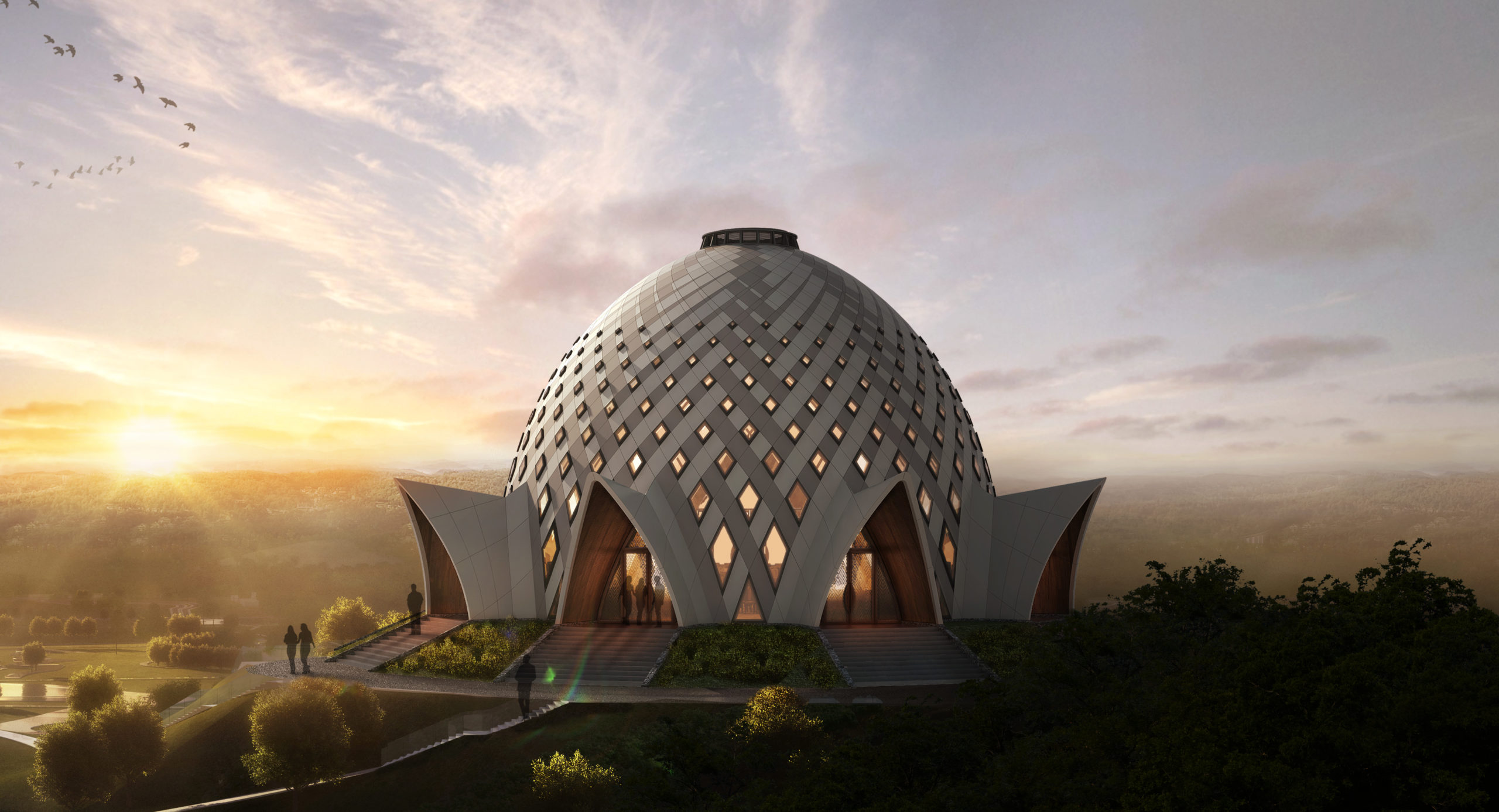
In some countries, such as the Democratic Republic of the Congo and Papua New Guinea, these seeds
have grown to the extent that the movement of entire populations toward the teachings of Bahá’u’lláh is becoming evident; thus, giving physical shape to the spiritual reality through the construction of a national House of Worship is timely. And as these teachings penetrate deeper and deeper into the soil of society,
44Universal House of Justice, Riḍván 2012. more national Houses of Worship will emerge. A similar process is visible in some small geographic areas (called clusters
) such as Battambang, Bihar Sharif, Matunda Soy, Norte del Cauca, and Tanna that have facilitated the raising up of great numbers of protagonists in the community-building activities within a concentrated space. As the Universal House of Justice noted at Riḍván 2012, The correlation of worship and service is especially pronounced in those clusters around the world where Bahá’í communities have significantly grown in size and vitality, and where engagement in social action is apparent.
45Universal House of Justice, Riḍván 2012. In such instances, the construction of a House of Worship becomes a logical extension of their efforts.
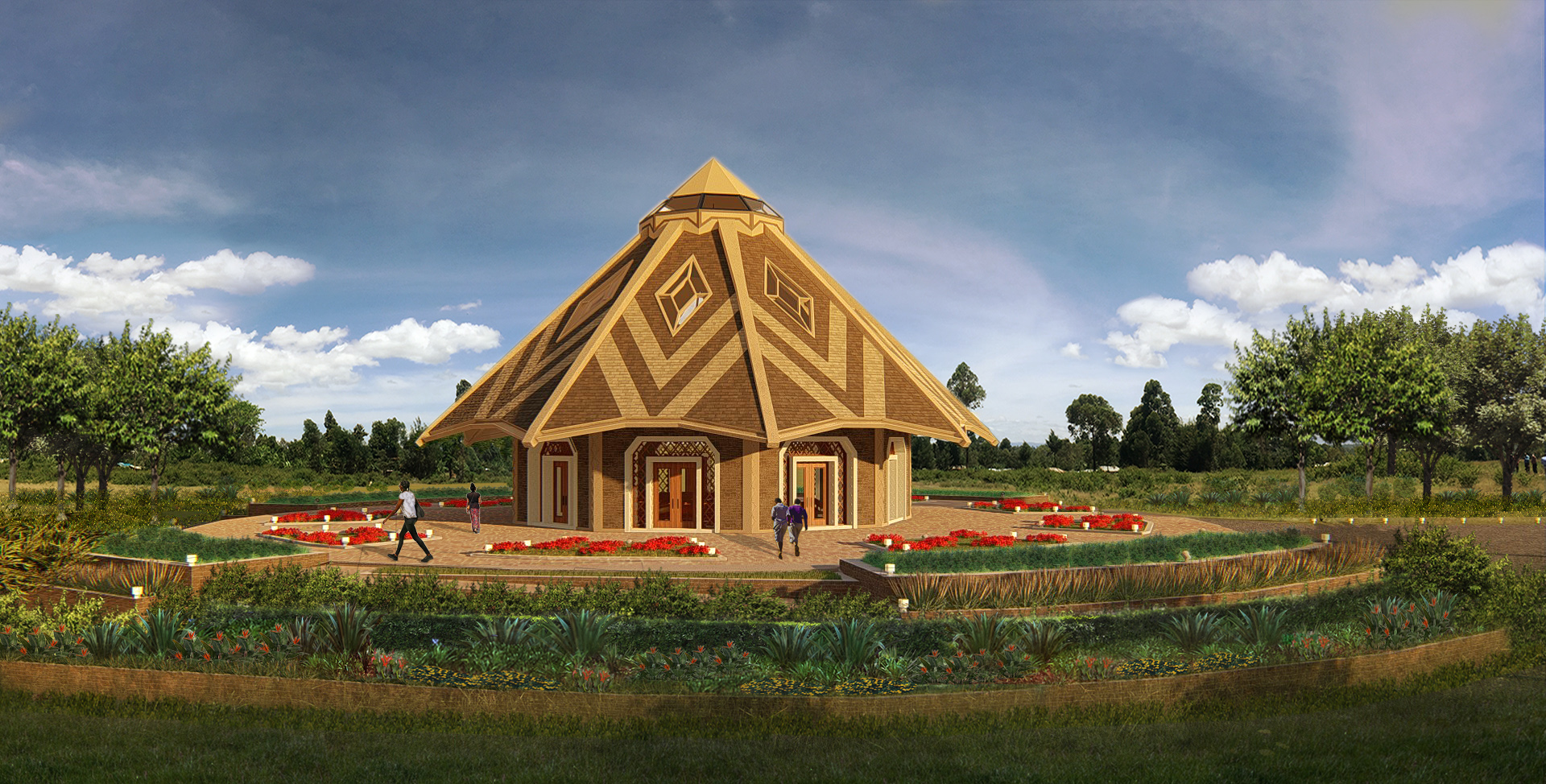
Clearly, much is being learned through these undertakings, and more will be written about them in the coming years. As such universal places of worship are given shape in more and more communities, providing for all inhabitants a haven for the deepest contemplation on spiritual reality and foundational questions of life, including individual and collective responsibility for the betterment of society
46Universal House of Justice, letter to the Bahá’ís of Iran (18 December 2014). In The Institution of the Mashriqu’l-Adhkár #67. and serving as an integral part of the process of community building,
47Universal House of Justice, letter to an individual believer (12 December 2013). In The Institution of the Mashriqu’l-Adhkár #78. members of the Bahá’í community are aware that ceaseless cooperation and mutual support
as well as sacrifice
must be the hallmark of their efforts.48From a letter written on behalf of Shoghi Effendi to the National Spiritual Assembly of Egypt (14 May 1936), translated from the Arabic. In The Institution of the Mashriqu’l-Adhkár #50. This, they have embraced in a spirit of joy and with a profound commitment to the process, eager to nurture communities of spiritual distinction
49From a letter to the Friends Gathered in Battambang, Cambodia, for the Dedication of the House of Worship (1 September 2017). In The Institution of the Mashriqu’l-Adhkár #70. and to galvanize an entire people to reach for a more profound sense of unified purpose.
50From a letter to the Friends Gathered in Santiago, Chile, for the Dedication of the Mother Temple of South America (14 October 2016). In The Institution of the Mashriqu’l-Adhkár #69.
It was Aristotle who first defined the word “community” as a group established by men having shared values. That initial definition has been refined and expanded through the years. We have come, for example, to recognize that people can belong to a number of different “communities” simultaneously—communities of place; cultural communities; communities of memory, in which people who may be strangers share “a morally significant history”; and psychological communities “of face-to-face personal interaction governed by sentiments of trust, co-operation, and altruism.”1Daniel Bell, Communitarianism and its Critics (Oxford: Clarendon Press, 1993), p. 14.
The world, we are repeatedly reminded, has contracted into a “global village.” One effect of this contraction is the bringing together of hitherto isolated peoples, allowing for the development of new patterns of civilization—but also creating new tensions. Thus, challenges now confront communities at local, national, and global levels. For example, new information technologies have created “networks” and “cybercommunities” in the world of the Internet that link individuals and organizations around the globe without regard for national boundaries; small communities around the planet are affected by urban migration or by degradation of the natural and built environment; the existence of national communities—nation states—is under threat from assaults by ethnic or tribal enclaves. Ironically, while the emergence of a global community wielding effective power is seen by many as a necessity in order to combat the ill effects of unfettered market economics, the whole idea that a real global community can ever come into existence is met with deep misgivings or complete skepticism by others. How, then, can we understand “community” at the end of the twentieth century—and what will its future be in the next millennium?
A number of significant challenges to community have arisen from developments in global information technologies. While pundits ponder whether or not Internet users form any kind of viable community as they sit at their computers in farflung corners of the world, a deeper and more serious issue is the manner in which the entire structure of computer networks undermines more traditional kinds of community organization.
As Jessica Mathews points out in her essay “Power Shift,” which appeared in a recent issue of Foreign Affairs, these new information technologies have challenged established societal hierarchies. They have empowered civil society, which in turn has allowed the world’s peoples generally to be more involved than previously in issues that were once the sole province of states and to forge new links between democracy, human rights, and international security. Yet, the technologies themselves are not always used to achieve constructive ends. They have, for example, also promoted the spread of global organized crime, and they have enabled individuals to cross borders easily to subvert governments and, at times, create new societal divisions.
The future of the state, in her view, is therefore uncertain. Information technologies, she points out “disrupt hierarchies, spreading power among more people and groups.” She continues,
In drastically lowering the costs of communication, consultation, and coordination, they favor decentralized networks over other modes of organization. In a network, individuals or groups link for joint action without building a physical or formal institutional presence. Networks have no person at the top and no center. Instead, they have multiple nodes where collections of individuals or groups interact for different purposes. Businesses, citizens organizations, ethnic groups, and crime cartels have all readily adopted the network model. Governments, on the other hand, are quintessential hierarchies, wedded to an organizational form incompatible with all that the new technologies make possible. 2Jessica T. Mathews, “Power Shift,” Foreign Affairs (January-February 1997), p. 52.
The technologies, she concludes, weaken community by empowering individuals, and her article contains this dire prediction:
The prophets of an internetted world in which national identities gradually fade, proclaim its revolutionary nature and yet believe the changes will be wholly benign. They won’t be. The shift from national to some other political allegiance, if it comes, will be an emotional, cultural, and political earthquake.3Jessica T. Mathews, “Power Shift,” Foreign Affairs (January-February 1997), p. 65.
Mathews raises important questions: What kind of community can be forged in an internetted world, where the structure of the technology promotes anarchy, with its emphasis on complete freedom of expression and lack of regard for authority? Does this spell the end of the nation-state and, if so, what other kind of political entity might arise in its stead? The challenges posed by the new information technologies may generate significant crises felt throughout the world, but such a development looms on the horizon.
There are, however, a number of current crises facing community. Loss of the sense of community based on “place” is a worldwide phenomenon. Millions of people all over the planet are being displaced from their homes. Some are refugees fleeing escalating political strife. Others are forced from their homes by economic necessity, such as farmers from rural China who are migrating to cities in vast numbers, searching for factory work. Such movement destroys families, undermines the traditional sense of trust found in community, increases feelings of isolation and dislocation, and creates a host of social problems.
Even where people still maintain their homes, there are challenges to the sense of place. A case in point is America, where planners are in revolt against the manner in which the built environment of communities has been shaped in the latter part of the twentieth century. A movement widely known by the name “new urbanism” protests against the “fantastic, awesome, stupefying ugliness” of “the gruesome, tragic suburban boulevards of commerce” so common in American towns and cities, contending that “this ugliness is the surface expression of deeper problems” and contributes substantially to the widely expressed sense of “loss of community” felt throughout the society.4James Howard Kunstler, “Home From Nowhere,” Atlantic Monthly (September 1996), p. 43.
The new urbanists posit that going back to the planning and design principles that shaped the traditional neighborhoods of America is a way of recapturing this lost sense of place and community, of reversing a pattern of development they see as “economically catastrophic, an environmental calamity, socially devastating, and spiritually degrading.” Discarding the zoning laws that segregate various activities, they seek to create neighborhoods (or hamlets or villages) of manageable size which, when clustered together, become towns and cities. Each neighborhood is constructed on a “human scale”; it contains both residential and commercial property and provides housing for people of different levels of income. The proposal is not fantastic. Many traditional European towns, for example, have preserved this element of “human design.” But to make such a change, citizens everywhere must take an active role in decisions regarding the environment in which they live:
Human settlements are like living organisms. They must grow, and they will change. But we can decide on the nature of that growth—on the quality and the character of it—and where it ought to go. We don’t have to scatter the building blocks of our civic life all over the countryside, destroying our towns and ruining farmland…. It is within our power to create places that are worthy of our affection.5James Howard Kunstler, “Home From Nowhere,” Atlantic Monthly (September 1996), p. 66.
Such loss of “community of place” can also bring loss of communities of memory and communities governed by trust. In the late nineteenth century Ferdinand Tönnies theorized that in the development of systems of culture, communities invariably move from a period of Gemeinschaft, where shared experience and likeness are most important, toward a period of Gesellschaft, where individuals exist in isolation from each other, there is a strong sense of competition, relationships are contractual, and monetary values prevail. Such a progression has been noted by others as well. In this century, Pitirim A. Sorokin, for example, saw societies moving through ideational, idealistic, and sensate stages, away from spiritual truth and values towards self-indulgence and material values. But is such a progression inevitable?
If we again take the case of America and look at it in Tönnies’ terms, we see that the society is in a period of Gesellschaft. William Leach, in his insightful 1993 volume Land of Desire, analyses the forces that have shaped modern America as “a distinct culture, unconnected to traditional family or community values, to religion in any conventional sense, or to political democracy…. The cardinal features of this culture were acquisition and consumption as the means of achieving happiness; the cult of the new; the democratization of desire; and money value as the predominant measure of all value in society.”6William Leach, Land of Desire: Merchants, Power, and the Rise of a New American Culture (New York: Random House, 1993), p. 3. As this culture grew, Leach writes, “Increasingly, the worth of everything—even beauty, friendship, religion, the moral life—was being determined by what it could bring in the market.”7William Leach, Land of Desire: Merchants, Power, and the Rise of a New American Culture (New York: Random House, 1993), p. 8.
Leach characterizes the dominant mode of interaction in twentieth century life as an amoral “brokering style,” the features of which are “repressing one’s own convictions and withholding judgment in the interest of forging profitable relationships.” Contending that it “occupies a preeminence in today’s political and moral economy,” he writes, “Brokers are now busy in nearly every sphere of activity, and they have helped inject into American culture a new amoralism essentially indifferent to virtue and hospitable to the ongoing inflation of desire.”8Leach, p. 11. Because America, with the collapse of communism, is now the world’s undisputed single superpower, its role as the leading exponent of Western capitalist values—which have been exported throughout the entire world—is crucial.
Indeed, some writers have gone so far as to characterize the current devotion to those values as a worldwide “religious” phenomenon. David Loy writes:
…our present economic system should also be understood as our religion, because it has come to fulfill a religious function for us. The discipline of economics is less a science than the theology of that religion, and its god, the Market, has become a vicious circle of ever-increasing production and consumption by pretending to offer a secular salvation. The collapse of communism—best understood as a capitalist “heresy”—makes it more apparent that the market is becoming the first truly world religion, binding all corners of the globe more and more tightly into a worldview and set of values whose religious role we overlook only because we insist on seeing them as “secular.”9David R. Loy, “The Religion of the Market,” Journal of the American Academy of Religion 62.2 (Summer 1997), p. 275.
George Soros shares this view, stating, “What used to be a medium of exchange has usurped the place of fundamental values…. The cult of success has replaced a belief in principles. Society has lost its anchor.”10George Soros, “The Capitalist Threat” in The Atlantic Monthly (February 1997), pp. 45-58. Concluding that “there is something wrong with making the survival of the fittest a guiding principle of civilized society,” he proposes an “open society” as the antidote to the havoc that laissez-faire capitalism and market values are wreaking in democratic society, where the guiding principles of “nonmarket values” are eclipsed by the influence of market values. Current confidence that “the unhampered pursuit of self-interest will bring about an eventual international equilibrium” is, in his view, “misplaced.” An “open society” would promote institutions that allow people to live together in peace, in spite of their different views, interests, and beliefs concerning what is true. He concludes, however, that there is currently no willingness to establish the means to preserve a global open society.
Another commentator, William Greider, in his book One World, Ready or Not: The Manic Logic of Global Capitalism, also contends that the widespread adoption of market economics does not and will not bring social and political stability, which have often been touted as long-term benefits. In fact, he says, the spread of market economics destroys the fabric of traditional societies and provides ideal conditions for contending political forces to fight each other for control.
In a response to Greider’s book in The Atlantic Monthly, Lester Thurow concurs, saying, “Capitalism is myopic and cannot make the long-term social investments in education, infrastructure, and research and development that it needs for its own future survival. It needs government help to make those investments, but its own ideology won’t allow it either to recognize the need for those investments or to request government help. That is the ideological paradox of our time.”11Lester Thurow, “The Revolution Upon Us” The Atlantic Monthly (March 1997), pp. 97-100.
According to Greider, we stand at a watershed in history: “A revolutionary principle is embedded in the global economic system, awaiting broader recognition: Human dignity is indivisible. Across the distances of culture and nations, across vast gulfs of wealth and poverty, even the least among us are entitled to dignity, and no justification exists for brutalizing them in the pursuit of commerce.”12William Greider, excerpted from One World: Ready or Not and published under the title “Planet of Pirates” in The Utne Reader (May-June 1997), pp. 72-73. He continues, “any prospect of developing a common global social consciousness will inevitably force people to reexamine themselves first and come to terms with their own national contradictions and hypocrisies. And just as Americans cannot claim a higher morality while benefiting from inhumane exploitation, neither can developing countries pretend to become modern `one world’ producers and expect exemption from the world’s social values.”13William Greider, excerpted from One World: Ready or Not and published under the title “Planet of Pirates” in The Utne Reader (May-June 1997), p. 102
While there is, as yet, no set of social values generally accepted by the world, attempts have recently been made to introduce an internationally accepted “Charter of Human Responsibilities.” This document would “provide a broader ethical context to the principles inherent within the Universal Declaration of Human Rights” to “accentuate those positive obligations each individual should assume in the service to humanity and the rest of creation.”14Taken from the Core Initiatives of “The State of the World Forum ’95.” The charter has not yet gained wide acceptance, but its formulation is a hopeful sign.
Values are also a main concern of Philip Selznick, a communitarian philosopher who contends not only that social justice must be the foundation of community but that it is the responsibility of both individuals and the collective. Thus, the communitarian concept of community is a “unity of unities”—a sort of “federal” unity that preserves the integrity of the parts by emphasizing individual moral autonomy as well as the moral bonds of civility, which are seen to be interdependence and reciprocity.15Philip Selznick, “Social Justice: A Communitarian Perspective,” in The Responsive Community 6.4 (Fall 1996), p. 15. For further discussion, see also Philip Selznick, The Moral Commonwealth: Social Theory and the Promise of Community (Berkeley: University of California Press, 1992), pp. 367-71. The concept of “stewardship” in governance further binds social power to moral ideals.16Philip Selznick, “Social Justice: A Communitarian Perspective,” in The Responsive Community 6.4 (Fall 1996), p. 15. For further discussion, see also Philip Selznick, The Moral Commonwealth: Social Theory and the Promise of Community (Berkeley: University of California Press, 1992), p. 22. It is a concept that looks outward rather than inward—or, as Selznick puts it, moves towards “the `we’ of humanity.”17Philip Selznick, “Social Justice: A Communitarian Perspective,” in The Responsive Community 6.4 (Fall 1996), p. 15. For further discussion, see also Philip Selznick, The Moral Commonwealth: Social Theory and the Promise of Community (Berkeley: University of California Press, 1992), p. 23. In this concept of community the balance of particularism and universalism is regarded as crucial, respecting diversity “without allowing its claims to override those of basic humanity and justice.”18Philip Selznick, “Social Justice: A Communitarian Perspective,” in The Responsive Community 6.4 (Fall 1996), p. 15. For further discussion, see also Philip Selznick, The Moral Commonwealth: Social Theory and the Promise of Community (Berkeley: University of California Press, 1992), p. 24.
It is not surprising that movements such as the communitarians have arisen to revisit the roots of Western society and to reexamine the values underpinning its culture. Their response to “the weakening of institutions, the blurred line between liberty and license, the widespread preference for short-run gains,” is to prescribe “more extensive responsibility in every aspect of personal experience and social life” as the antidote.19Philip Selznick, “Social Justice: A Communitarian Perspective,” in The Responsive Community 6.4 (Fall 1996), p. 15. For further discussion, see also Philip Selznick, The Moral Commonwealth: Social Theory and the Promise of Community (Berkeley: University of California Press, 1992), p. 13.
Two other communitarians have offered some valuable insights into a community-friendly, sustainable system of economics. In their book For the Common Good, Herman E. Daly and John B. Cobb, Jr., make a distinction between two different paradigms of economic behavior: chrematistics and oikonomia. Chrematistics, they say, “can be defined as the branch of political economy relating to the manipulation of property and wealth so as to maximize short-term monetary exchange value to the owner”—a model that conforms to Leach’s, Soros’ and Greider’s view of capitalism, as epitomized by the American system. In contrast, oikonomia “is the management of the household so as to increase its use value to all members of the household over the long run.” They continue, “If we expand the scope of household to include the larger community of the land, of shared values, resources, biomes, institutions, language, and history, then we have a good definition of `economics for community.'”20Herman E. Daly and John B. Cobb, Jr., For the Common Good: Redirecting the Economy Toward Community, the Environment, and a Sustainable Future (Boston: Beacon Press, 1989), p. 138.
The concept of oikonomia seems quite close to Selznick’s “stewardship.” Cobb and Daly’s assertion that “True economics concerns itself with the long-term welfare of the whole community”21Herman E. Daly and John B. Cobb, Jr., For the Common Good: Redirecting the Economy Toward Community, the Environment, and a Sustainable Future (Boston: Beacon Press, 1989), p. 159 posits a conception of humans as something quite different from mere consumers—and of community as something much different from a mere marketplace. They argue that seeing people only as beings “bent on optimizing utility or satisfaction through procuring unlimited commodities,”22Herman E. Daly and John B. Cobb, Jr., For the Common Good: Redirecting the Economy Toward Community, the Environment, and a Sustainable Future (Boston: Beacon Press, 1989), p. 159. which is the view underlying current economic theory, leads to “policies that weaken existing patterns of social relationships.”23Herman E. Daly and John B. Cobb, Jr., For the Common Good: Redirecting the Economy Toward Community, the Environment, and a Sustainable Future (Boston: Beacon Press, 1989), p. 163. They advocate, instead, that “economics should be refounded on the basis of a new concept of Homo economicus as person-in-community,”24Herman E. Daly and John B. Cobb, Jr., For the Common Good: Redirecting the Economy Toward Community, the Environment, and a Sustainable Future (Boston: Beacon Press, 1989), p. 164. recognizing that
the well-being of a community as a whole is constitutive of each person’s welfare…because each human being is constituted by relationships to others, and this pattern of relationships is at least as important as the possession of commodities. These relationships cannot be exchanged in a market. They can, nevertheless, be affected by the market, and when the market grows out of the control of a community, the effects are almost always destructive. Hence this model of person-in-community calls not only for provision of goods and services to individuals, but also for an economic order that supports the pattern of personal relationships that make up the community.25Daly and Cobb, pp. 164-165.
Daly and Cobb argue strongly for a conscious movement towards the adoption of social behavior and values that will enhance “the common good” and build the foundations of a community that will protect the environment and promote ways of living that provide for a sustainable future. Such an approach addresses some of the key challenges facing community.
At the broadest level of discussion, many contemporary thinkers, such as Daly and Cobb, see the global nature of environmental crises and the interconnectedness of national economies, for example, as leading inexorably towards the establishment of a global community of some sort. Others, however, see the whole idea as an utter impossibility. Some of the most provocative pieces to appear in print on this topic during the past several years have been authored by Samuel P. Huntington, whose essay “The Clash of Civilizations?” in Foreign Affairs sparked a firestorm of debate on his thesis that the emergence of a global civilization is a utopian fantasy. Huntington later expanded his position to a full-length book, notably dropping the question mark at the end of the title to read The Clash of Civilizations and the Remaking of World Order.
The phrase “world community” “has become the euphemistic collective noun (replacing `the Free World’) to give global legitimacy to actions reflecting the interests of the United States and other Western powers,”26Samuel P. Huntington, The Clash of Civilizations and the Remaking of World Order (New York: Simon and Schuster, 1996), p. 184. he contends. The West, whose system of liberal democracy has recently been touted as the pinnacle of social evolution and achievement, is not, in his view, a universal civilization. “What is universalism to the West is imperialism to the rest,” he states.27Samuel P. Huntington, The Clash of Civilizations and the Remaking of World Order (New York: Simon and Schuster, 1996), p. 184.
While Huntington focuses on “civilization,” which he defines as “the highest cultural grouping of people and the broadest level of cultural identity people have short of that which distinguishes humans from other species,” the elements he sees as shaping civilizations are quite similar to those generally accepted as characteristics of community: “common objective elements, such as language, history, religion, customs, institutions” and “the subjective self-identification of people.”28Samuel P. Huntington, The Clash of Civilizations and the Remaking of World Order (New York: Simon and Schuster, 1996), p. 43.
He is extremely skeptical that any kind of unified global civilization can ever develop. At the individual level, he asserts that there must always be “the civilizational `us’ and the extracivilizational `them'” because we fear and distrust people who are different; we experience difficulty in communicating with them; and we are unfamiliar with what motivates them, how they conduct social relationships, and so on.29Samuel P. Huntington, The Clash of Civilizations and the Remaking of World Order (New York: Simon and Schuster, 1996), p. 129. In opposition to Daly and Cobb, he states that “it is human to hate”; “for self-definition and motivation people need enemies: competition in business, rivals in achievement, opponents in politics. They naturally distrust and see as threats those who are different and have the capability to harm them.”30Samuel P. Huntington, The Clash of Civilizations and the Remaking of World Order (New York: Simon and Schuster, 1996), p. 130. This rivalry extends to the sphere of religion. As Huntington says, “Whatever universalist goals they may have, religions give people identity by positing a basic distinction between believers and nonbelievers, between a superior in-group and a different and inferior out-group.”31Samuel P. Huntington, The Clash of Civilizations and the Remaking of World Order (New York: Simon and Schuster, 1996), p. 97. Further, “if a universal civilization is emerging,” he asserts, “there should be signs of a universal language and a universal religion developing.” He concludes, “Nothing of the sort is occurring.”32Samuel P. Huntington, “The Many Faces of the Future,” The Utne Reader (May-June 1997), pp. 75-77.
Andrew Bard Schmookler, while also identifying “intersocietal anarchy” as “the overarching context of civilized life,” is somewhat more optimistic than Huntington about the development of a united global civilization. “As long as the human cultural system was fragmented into a multiplicity of separate units,” he asserts, “the problem of power remained insoluble.”33Andrew Bard Schmookler, The Parable of the Tribes: The Problem of Power in Social Evolution (Boston: Houghton Mifflin Co., 1984), p. 33. He contends that now “an escape from this fragmented system is beginning to emerge,” although dangers still remain:
For the first time, the world is becoming a single interdependent system in which all the world’s peoples are in contact. Meanwhile, the age-old struggle for power goes on and may annihilate us before we can create an order that controls power. But the centuries ahead give us the opportunity to place all human action within a structure that for the first time makes truly free human choice possible. Even so, it is far from clear how to get from here to there, or even what kind of world order “there” should be.34Andrew Bard Schmookler, The Parable of the Tribes: The Problem of Power in Social Evolution (Boston: Houghton Mifflin Co., 1984), pp. 33-34.
To avoid such conflict, he asserts that if we reflect on “higher ideals,”
we will discover that there is less difference between East and West than is often made out to be….The challenge at hand is to conceive a common vision of the future which goes beyond our current concerns and preoccupations, advancing toward the creation of a global community, dominated neither by the East nor the West, but dedicated to the ideals of both.35Anwar Ibrahim, “A Global Convivencia vs. The Clash of Civilizations,” excerpted in New Perspectives Quarterly (Summer 1997), p. 41.
To avoid such conflict, he asserts that if we reflect on “higher ideals,”
we will discover that there is less difference between East and West than is often made out to be….The challenge at hand is to conceive a common vision of the future which goes beyond our current concerns and preoccupations, advancing toward the creation of a global community, dominated neither by the East nor the West, but dedicated to the ideals of both.36Ibrahim, p. 41.
He advocates a “civilizational dialogue,” undertaken with the goal of achieving a “global convivencia—a harmonious and enriching experience of living together among people of diverse religions and cultures.”37Ibrahim, p. 42.
The uncertain hope expressed by Schmookler, the pessimism of Huntington, the fundamental structural changes described by Mathews, the ills outlined by Leach, Greider, Soros, and others, and the prescriptions advanced by Daly, Cobb, Selznick, and Ibrahim all provide differing perspectives on the strenuous debate currently taking place around the subject of community. Where the world will go from here remains uncertain. Various individuals and organizations have attempted to address the ills of society, which are generally perceived to be worldwide in scope, but, as Soros comments rather bitterly, no will exists to establish institutions and mechanisms that would effectively govern a global community. And certainly there is no wide agreement about what exactly the fundamental values of such a community should be.
It is clear from the number and variety of problems confronting humanity at this stage in its history that community development must be pursued at all levels, from the local to the global. Religion is one powerful means to address these problems, since it has traditionally been concerned with two broad questions: the purpose of existence and the nature of the community. In fact, the word “religion” itself is derived from religio, meaning “to bind together.”
Members of the world’s youngest independent religion, the Bahá’í Faith, who now number some five million souls from more than 2,000 tribes, races, and ethnic groups, have forged a united, dynamic community that is flourishing at the local, national, and global levels. The vision that unites this diverse group comes from Bahá’u’lláh, the Founder of the Bahá’í Faith. He taught that all people worship one God, Who has guided the development of humanity through successive Messengers Who have founded the world’s major religions. The human race, Bahá’u’lláh said, now stands at the threshold of maturity, and the time has come for the uniting of all peoples into a peaceful and integrated global society. His prescriptions for humanity all lead toward that end.
Bahá’ís are, therefore, deeply concerned with the process of community building. To help them advance in their understanding of this issue, the Universal House of Justice, the Faith’s international governing council, has offered a definition of “community,” which it characterizes as “more than the sum of its membership”:
it is a comprehensive unit of civilization composed of individuals, families and institutions that are originators and encouragers of systems, agencies and organizations working together with a common purpose for the welfare of people both within and beyond its own borders; it is a composition of diverse, interacting participants that are achieving unity in an unremitting quest for spiritual and social progress.38The Universal House of Justice, Ridvan letter to the Bahá’ís of the world, B.E. 153 (April 1996).
Because spiritual values have the power to simultaneously unite peoples and transform political order into a moral community, the Bahá’í Faith has tremendous capacities to promulgate the model of a healthy, dynamic community. Indeed, Shoghi Effendi, the Guardian of the Faith, writing about the Bahá’ís, once referred to “the society-building power which their Faith possesses.”39Shoghi Effendi, The World Order of Bahá’u’lláh: Selected Letters (Wilmette: Bahá’í Publishing Trust, 1991), p. 195.
The principle that has enabled the Bahá’í Faith to achieve an unprecedented level of unity as a world community and yet preserve local communities’ and individuals’ unique identities is that of “unity in diversity,” about which Shoghi Effendi offers this commentary:
The Faith of Bahá’u’lláh has assimilated, by virtue of its creative, its regulative and ennobling energies, the varied races, nationalities, creeds and classes that have sought its shadow, and have pledged unswerving fealty to its cause. It has changed the hearts of its adherents, burned away their prejudices, stilled their passions, exalted their conceptions, ennobled their motives, coordinated their efforts, and transformed their outlook. While preserving their patriotism and safeguarding their lesser loyalties, it has made them lovers of mankind, and the determined upholders of its best and truest interests. While maintaining intact their belief in the Divine origin of their respective religions, it has enabled them to visualize the underlying purpose of these religions, to discover their merits, to recognize their sequence, their interdependence, their wholeness and unity, and to acknowledge the bond that vitally links them to itself. This universal, this transcending love which the followers of the Bahá’í Faith feel for their fellow-men, of whatever race, creed, class or nation, is neither mysterious nor can it be said to have been artificially stimulated. It is both spontaneous and genuine. They whose hearts are warmed by the energizing influence of God’s creative love cherish His creatures for His sake, and recognize in every human face a sign of His reflected glory.40Shoghi Effendi, The World Order of Bahá’u’lláh, pp. 197-98.
This sense of spiritual unity that provides the basis of community structure pervades all aspects of Bahá’í community life. As one writer puts it,
…the meaning of Community is a meaning which can only be gradually unfolded as our experience in living the ideals of Community grows and evolves. Beyond our sense of friendship and fellowship and social interaction there is the reality of spiritual unity….
…unity is the essence of the Bahá’í Faith, because it is the principle of spiritual unity applied at a social level, a spiritual unity which has never before been realized in any community, a spiritual unity which flows from the communion of the individual soul with God and from the vision of God revealed in the soul of every other believer in that Community.41John Davidson, A Bahá’í Approach to Community: Process and Promise, Vol. 1, Bahá’í Studies in Australasia: Bahá’í Community and Institutions (Association for Bahá’í Studies-Australia, 1993), p. 36.
True civilization does not arise from material progress, but rather is founded on the transcendent values that hold society together. Bahá’ís believe that the theories and practices that promote self-indulgence and disrupt the connections among individuals must be directly challenged. Service to humanity and a commitment to a deeper level of engagement with each other and the problems of society are key motivating forces behind the Bahá’í community. As Bahá’u’lláh has written:
That one indeed is a man who, today, dedicateth himself to the service of the entire human race…. Blessed and happy is he that ariseth to promote the best interests of the peoples and kindreds of the earth…. It is not for him to pride himself who loveth his own country, but rather for him who loveth the whole world. The earth is but one country, and mankind its citizens.42Bahá’u’lláh, Gleanings from the Writings of Bahá’u’lláh (Wilmette: Bahá’í Publishing Trust, 1983), p. 250.
Such service is the hallmark of true religion. In the words of `Abdu’l-Bahá, son of Bahá’u’lláh:
Universal benefits derive from the grace of the Divine religions, for they lead their true followers to sincerity of intent, to high purpose, to purity and spotless honor, to surpassing kindness and compassion, to the keeping of their covenants when they have covenanted, to concern for the rights of others, to liberality, to justice in every aspect of life, to humanity and philanthropy, to valor and to unflagging efforts in the service of mankind. It is religion, to sum up, which produces all human virtues, and it is these virtues which are the bright candles of civilization.43Abdu’l-Bahá, The Secret of Divine Civilization (Wilmette: Bahá’í Publishing Trust, 1994), p. 98.
To support the spiritual unity and desire to serve humanity that form the basis of community in Bahá’u’lláh’s teachings, a structure to guard that unity and to promote acts of service is also explicitly laid out in the Faith’s sacred writings. As the eminent Bahá’í writer Horace Holley comments:
Faith alone, no matter how wholehearted and sincere, affords no basis on which the organic unity of a religious fellowship can endure…
The Bahá’í teaching has this vital distinction, that it extends from the realm of conscience and faith to the realm of social action. It confirms the substance of faith not merely as a source of individual development but as a definitely ordered relationship to the community.44Horace Holley, “Aims and Purposes of the Bahá’í Faith,” The Bahá’í World, Vol. XII (1950-54), p. 8.
He goes on to discuss the nature of the authority to which Bahá’ís commit themselves:
Sovereignty, in the Bahá’í community, is attributed to the Divine prophet, and the elected representatives of the believers in their administrative function look to the teachings of Bahá’u’lláh for their guidance, having faith that the application of His universal principles is the source of order throughout the community. Every Bahá’í administrative body feels itself a trustee, and in this capacity stands above the plane of dissension and is free of that pressure exerted by factional groups.45Horace Holley, “Aims and Purposes of the Bahá’í Faith,” The Bahá’í World, Vol. XII (1950-54), p. 9.
Here one finds an application of the concept of “stewardship,” as mentioned by Selznick. Indeed, as Holley says, the Local Spiritual Assembly, the council that is elected annually, “represents the collective conscience of the community with respect to Bahá’í activities.”46Horace Holley, “Aims and Purposes of the Bahá’í Faith,” The Bahá’í World, Vol. XII (1950-54), p. 9. In short,
Spiritual Assemblies, local and national, combine an executive, a legislative and a judicial function, all within the limits set by the Bahá’í teachings…. They are primarily responsible for the maintenance of unity within the Bahá’í community and for the release of its collective power in service to the Cause.47Horace Holley, “Aims and Purposes of the Bahá’í Faith,” The Bahá’í World, Vol. XII (1950-54), p. 9.
The administrative model conceived by Bahá’u’lláh promotes a concept of leadership embodying trustworthiness, wisdom, and willingness to sacrifice for the common good, and whose highest expression is service to the community. It also fosters collective decision making and collective action through a process called “consultation.” Conducted in a spirit of unity, its purpose is to search out the truth. Those engaged in the process are enjoined to express their views with “all freedom,” but at the same time “with the utmost devotion, courtesy, dignity, care, and moderation.”48Abdu’l-Bahá, cited in Consultation: A Compilation (Wilmette: Bahá’í Publishing Trust, 1980), #10, p. 6. In this way, participants can avoid antagonism and conflict, and all can freely express their views without fear of displeasing or alienating anyone. Here, one sees how the “right” of freedom of speech is balanced by the “responsibility” of moderate expression. Indeed, Bahá’u’lláh states that “Human utterance is an essence which aspireth to exert its influence and needeth moderation.” Its influence, He says, “is conditional upon refinement which in turn is dependent upon hearts which are detached and pure,” and its moderation should be “combined with tact and wisdom.”49Bahá’u’lláh, Tablets of Bahá’u’lláh Revealed after the Kitab-i-Aqdas (Wilmette: Bahá’í Publishing Trust, 1995), p. 143.
Because the Bahá’í community—just a century and a half old—is only “at the very beginning of the process of community building,” the House of Justice also provides, in its Ridvan 1996 letter, guidance regarding the elements necessary for healthy community growth. To facilitate the healthy growth of communities that can engage in an “unremitting quest for spiritual and social progress,” the House of Justice emphasizes that they must promote patterns of behavior “by which the collective expression of the virtues of the individual members and the functioning of the Spiritual Assembly are manifest in the unity and fellowship of the community and the dynamism of its activity and growth.” These patterns include the integration and inclusion of all the adults, youth, and children in “spiritual, social, educational and administrative activities,” as well as “local plans of teaching and development.” Another distinctive pattern of behavior is seen in the “collective will and sense of purpose” to establish and maintain Bahá’í administrative institutions, particularly evident in the annual election of Spiritual Assemblies in communities around the world. A final pattern involves “the practice of collective worship of God” through regular devotional meetings, seen as “essential to the spiritual life of the community.”
And indeed, the spirit of unity underlying their communities and the structures that govern them are not only for Bahá’ís, who believe that through time a unified global community will be forged, whether “reached only after unimaginable horrors precipitated by humanity’s stubborn clinging to old patterns of behavior” or “embraced now by an act of consultative will.”50The Universal House of Justice, The Promise of World Peace (Haifa: Bahá’í World Centre, 1985), p. 1. As Shoghi Effendi wrote,
Unification of the whole of mankind is the hall-mark of the stage which human society is now approaching. Unity of family, of tribe, of city-state, and nation have been successively attempted and fully established. World unity is the goal towards which a harassed humanity is striving. Nation-building has come to an end. The anarchy inherent in state sovereignty is moving towards a climax. A world, growing to maturity, must abandon this fetish, recognize the oneness and wholeness of human relationships, and establish once for all the machinery that can best incarnate this fundamental principle of its life.51Shoghi Effendi, The World Order of Bahá’u’lláh, p. 202.
Shoghi Effendi describes the global society promised in the Bahá’í sacred writings as follows:
A world community in which all economic barriers will have been permanently demolished and the interdependence of Capital and Labor definitely recognized; in which the clamor of religious fanaticism and strife will have been forever stilled; in which the flame of racial animosity will have been finally extinguished; in which a single code of international law—the product of the considered judgment of the world’s federated representatives—shall have as its sanction the instant and coercive intervention of the combined forces of the federated units; and finally a world community in which the fury of a capricious and militant nationalism will have been transmuted into an abiding consciousness of world citizenship—such indeed, appears, in its broadest outline, the Order anticipated by Bahá’u’lláh, an Order that shall come to be regarded as the fairest fruit of a slowly maturing age.52Shoghi Effendi, The World Order of Bahá’u’lláh, p. 41.
In the Bahá’í view, such a development is not a utopian vision; it is the next and highest step in the development of “an ever-advancing civilization,” “the furthermost limits in the organization of human society.”53Shoghi Effendi, The World Order of Bahá’u’lláh, p. 163.
A response to Huntington’s objection that there can be no global civilization because no universal religion or language is emerging is found within the Bahá’í Faith. First, it is a universal religion. As Bahá’u’lláh wrote over one hundred years ago,
There can be no doubt whatever that the peoples of the world, of whatever race or religion, derive their inspiration from one heavenly Source, and are the subjects of one God. The difference between the ordinances under which they abide should be attributed to the varying requirements and exigencies of the age in which they were revealed. All of them, except a few which are the outcome of human perversity, were ordained of God, and are a reflection of His Will and Purpose.54Bahá’u’lláh, Gleanings, p. 217.
Further, He states,
Verily I say, this is the Day in which mankind can behold the Face, and hear the Voice, of the Promised One…. Great indeed is this Day! The allusions made to it in all the sacred Scriptures as the Day of God attest its greatness. The soul of every Prophet of God, of every Divine Messenger, hath thirsted for this wondrous Day. All the divers kindreds of the earth have, likewise, yearned to attain it.55Bahá’u’lláh, Gleanings, pp. 10-11.
With regard to the choice or development of a single language, Bahá’u’lláh says in His book of laws:
O members of parliaments throughout the world! Select ye a single language for the use of all on earth, and adopt ye likewise a common script…. This will be the cause of unity, could ye but comprehend it, and the greatest instrument for promoting harmony and civilization, would that ye might understand!56Bahá’u’lláh, The Kitab-i-Aqdas: The Most Holy Book (Wilmette: Bahá’í Publishing Trust, 1993), p. 87, paragraph 189.
While all the elements necessary for the establishing of a global society are present in the Bahá’í sacred writings, the forging of a world community will, in the words of Shoghi Effendi, be a “gradual process.” The first step towards it will be the establishment of what Bahá’ís call “the Lesser Peace,” a political union reached by the nations of the world:
This momentous and historic step, involving the reconstruction of mankind, as the result of the universal recognition of its oneness and wholeness, will bring in its wake the spiritualization of the masses, consequently to the recognition of the character, and the acknowledgment of the claims, of the Faith of Bahá’u’lláh—the essential condition to that ultimate fusion of all races, creeds, classes, and nations which must signalize the emergence of His New World Order.57Shoghi Effendi, The Promised Day Is Come (Wilmette: Bahá’í Publishing Trust, 1980), p. 123.
“Then,” Shoghi Effendi continues, “will the coming of age of the entire human race be proclaimed and celebrated by all the peoples and nations of the earth.” The “Most Great Peace” will be established with the universal recognition of the message of unity brought by Bahá’u’lláh, following which “a world civilization [will] be born, flourish, and perpetuate itself, a civilization with a fullness of life such as the world has never seen nor can as yet conceive.”58Shoghi Effendi, The Promised Day Is Come (Wilmette: Bahá’í Publishing Trust, 1980), pp. 123-24.
The establishment of a world civilization, promoting an unimaginable “fullness of life,” is assured. With confidence in the eventual achievement of this aim, Bahá’ís face the uncertainty of the transition period in which we are now living.
While others are not so confident, even the more pessimistic express some vague hope that a peaceful world community will somehow arrive. At the end of his book The Ends of the Earth: A Journey at the Dawn of the 21st Century, Robert Kaplan asks a crucial question: “As a species, we can imagine justice and harmony. But how can justice and harmony be possible for much of humanity, given the evidence of history, plus the inflammatory potential of a fourfold increase in population since the nineteenth century, with antennas rising from mudhuts to allow the poor to see how the rich live?”59Robert D. Kaplan, The Ends of the Earth: A Journey at the Dawn of the 21st Century (New York: Random Books, 1996), p. 437. Kaplan has no answer to this question, but he closes his book with a quotation from the poem “Addressed to Haydon” by the visionary English poet John Keats:
And other spirits…are standing apart
Upon the forehead of the age to come;
These, these will give the world another heart,
And other pulses. Hear ye not the hum
Of mighty workings?—
Listen awhile ye nations, and be dumb.
Bahá’u’lláh delivered His message to humanity short years after Keats penned these lines. “The world’s equilibrium,” He stated, “hath been upset by the vibrating influence of this most great, this new World Order. Mankind’s ordered life hath been revolutionized through the agency of this unique, this wondrous System—the like of which mortal eyes have never witnessed.”60Bahá’u’lláh, The Kitab-i-Aqdas, p. 84, para. 181. Bahá’u’lláh called the peoples of the world together in unity; He delineated the structure of a community that can function unitedly on the local, national, and global levels to promote justice and build a peaceful world. When considering the challenges facing communities at the end of the twentieth century, thinking people would do well to study the model that has brought together, in some 153 years, more than five million people from extremely diverse backgrounds and has enabled them to establish a single, united global community that both nourishes the individual and safeguards the good of the whole. These are indeed, in Keats’ words, “mighty workings”: here is a model that can benefit all the inhabitants of the planet.
At the Habitat II conference in Istanbul , in June 1996, the Bahá’í International Community shared its vision of communities of the future—a vision that addresses many of the challenges facing us at the end of this turbulent century:
Communities that thrive and prosper in the new millennium will do so because they acknowledge the spiritual dimension of human nature and make the moral, emotional, and intellectual development of the individual a central priority. They will guarantee freedom of religion and encourage the establishment of places of worship. Their centers of learning will seek to cultivate the limitless potentialities latent in human consciousness and will pursue as a major goal the participation of all peoples in generating and applying knowledge. Remembering at all times that the interests of the individual and of society are inseparable, these communities will promote respect for both rights and responsibilities, will foster the equality and partnership of women and men, and will protect and nurture families. They will promote beauty, natural, and man-made, and incorporate into their design principles of environmental preservation and rehabilitation. Guided by the concept of unity in diversity, they will support widespread participation in the affairs of society, and will increasingly turn to leaders who are motivated by the desire to serve. In these communities the fruits of science and technology will benefit the whole society, and work will be available for all.
Communities such as these will prove to be the pillars of a world civilization—a civilization which will be the logical culmination of humanity’s community-building efforts over vast stretches of time and geography. Bahá’u’lláh’s statement that all people are “born to carry forward an ever-advancing civilization,” implies that every person has both the right and the responsibility to contribute to this historic and far-reaching, collective enterprise whose goal is nothing less than the peace, prosperity, and unity of the entire human family.61The Bahá’í International Community, Sustainable Communities in an Integrating World, a concept paper shared at the Second United Nations Conference on Human Settlements (Habitat II), Istanbul, Turkey, 3-14 June 1996.